When many people think of Peru, the first thing that comes to mind is Machu Picchu. It’s without a doubt the most famous tourist destination in Peru.
But not far behind is Peruvian food.
For all but one year from 2012 to 2019, Peru was voted the Best Culinary Destination in South America by the World Travel Awards. It’s known for its agricultural diversity and multitude of global culinary influences that have helped make Peruvian food one of the tastiest and most interesting cuisines in the world.
For many travelers, Machu Picchu is what draws them to Peru. But as these next thirty dishes will show you, traditional Peruvian food is what makes them come back for more.
PERUVIAN FOOD QUICK LINKS
If you’re planning a trip to Peru and want to learn more about the cuisine, then you may be interested in going on a food tour or taking a cooking class.
TOURS & OTHER SERVICES
- Food Tours: Food and Wine/Drinking Tours in Peru
- Cooking Classes: Cooking Classes in Peru
- eSIM: Peru eSIM
Save This on Pinterest!
No time to read this Peruvian food guide now? Click on the save button and pin it for later!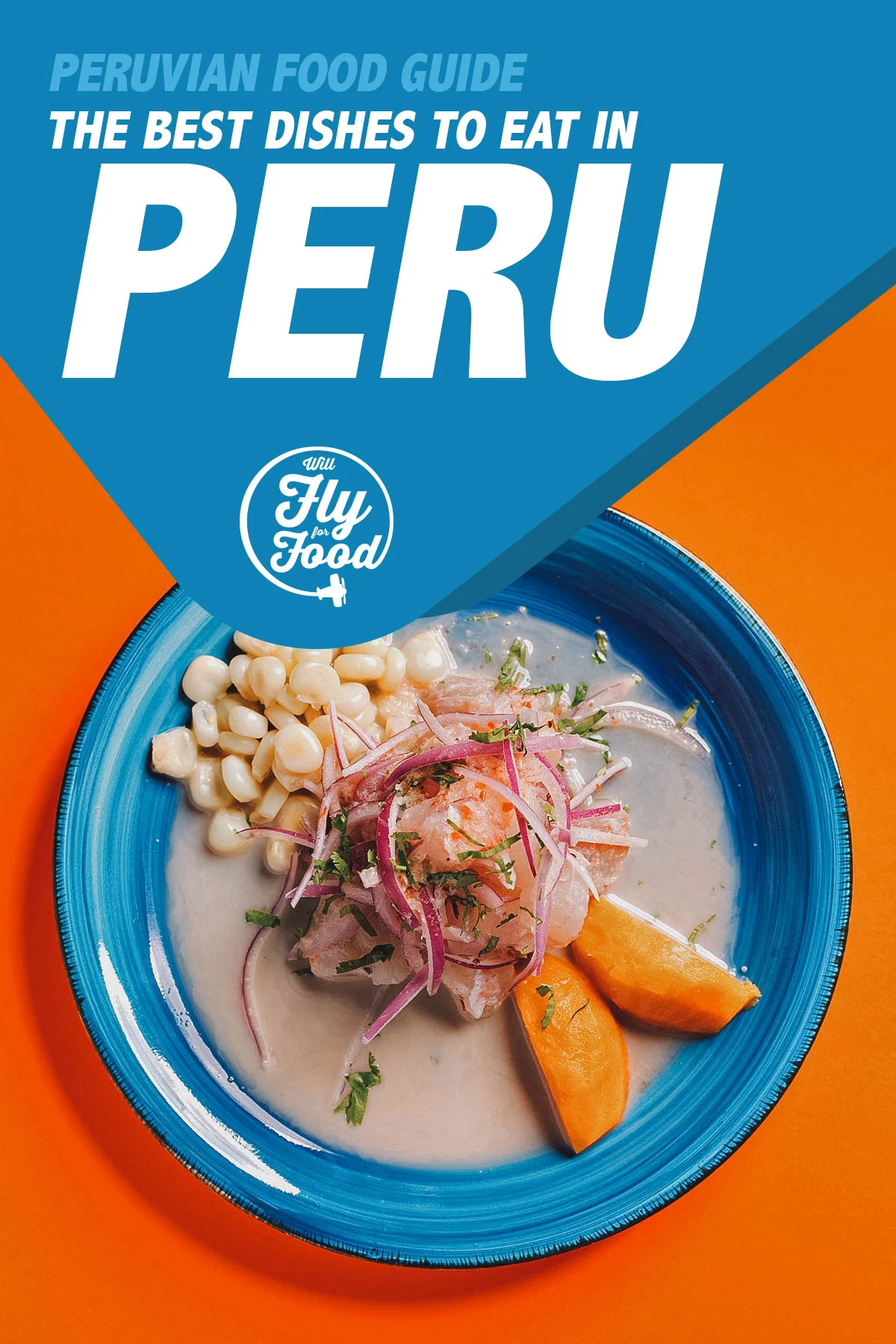
Photo by jgfotografia
WHAT IS TRADITIONAL PERUVIAN FOOD?
If you were to describe Peruvian cuisine with just one word, it would be multicultural. It’s a mix of indigenous, Spanish, Moorish, Chinese, Japanese, and African influences that have come together to create one of the world’s most interesting food cultures.
When immigrants settled in Peru, they didn’t have the usual ingredients they were accustomed to at home so they modified their recipes using local Peruvian ingredients. This gave rise to newer culinary traditions within Peruvian cuisine like Creole, Nikkei, and chifa cooking. These cooking techniques would develop over the generations and become very much a part of Peruvian cuisine.
Thanks to its long multicultural history, many food writers have described Peruvian food as the truest example of fusion cuisine.
MUST-TRY PERUVIAN DISHES
A list of 30 dishes can be difficult to digest so I’ve organized this guide on traditional Peruvian food by category to make it easier to go through. Click on a link to jump to any section of the guide.
SEAFOOD
1. Ceviche
There’s no better way to start this Peruvian food guide than with ceviche. It’s a Peruvian national dish that’s become popular throughout the Pacific coastal regions of Latin America and beyond, including the Philippines.
Originally from Peru, ceviche refers to a dish made from fresh raw white fish cured in citrus juices. Historically, it used to be made with the juice from bitter oranges but modern versions are more commonly made with lemon or lime juice.
The citric acid from the fruit causes the fish to become denatured, giving it the appearance of being cooked. It’s typically spiced with aji (Peruvian capsicum), chili pepper, red onions, coriander, salt, pepper, and other seasonings.
Because ceviche isn’t cooked, it needs to be made with the freshest fish (sashimi-grade) and consumed immediately. It’s typically eaten as an appetizer though it can be enjoyed as a main course with various Peruvian side dishes as well.
Though ceviche is widely accepted to be a part of Peruvian cuisine, it’s exact origins are unclear. One of the most accepted theories is that it was brought to Peru by Moorish women from Andalusia. They accompanied the conquistadores and brought with them a dish that evolved over time to become ceviche.
RECIPE: Peruvian ceviche
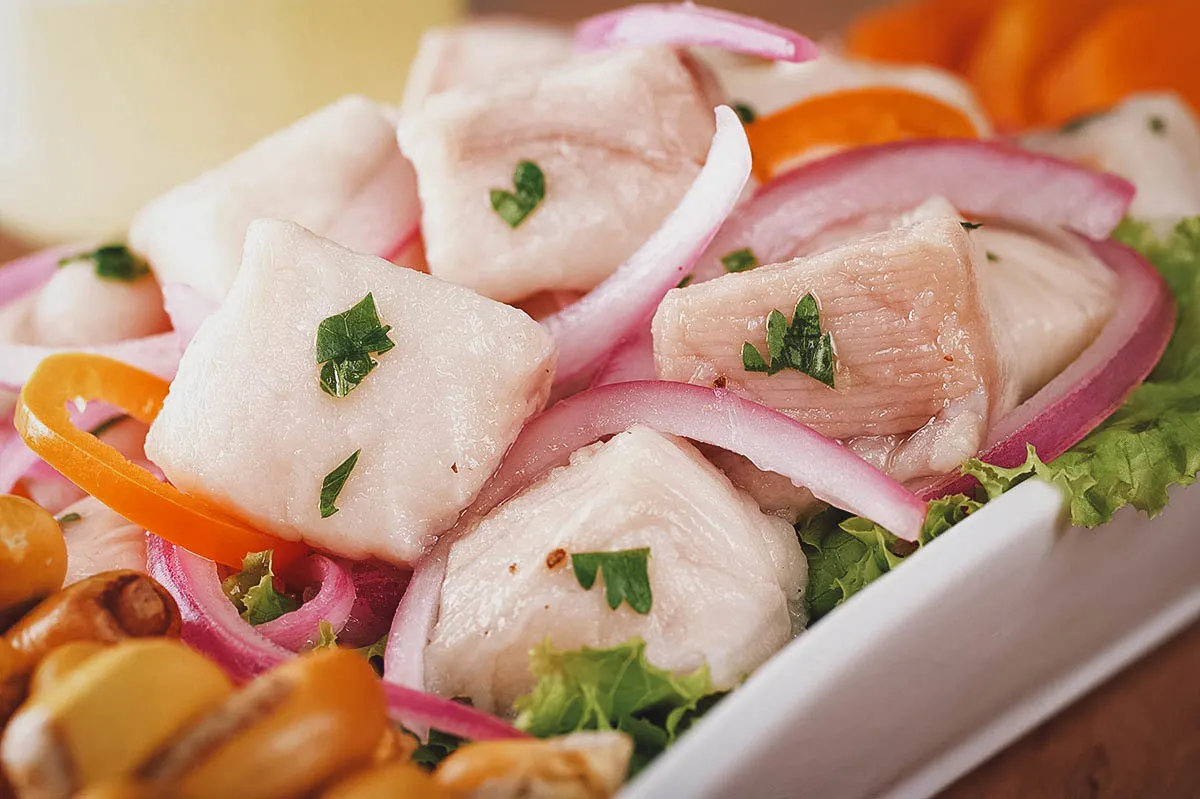
Photo by ildi_papp
2. Tiradito
Tiradito refers to a ceviche-like Peruvian dish made with raw fish sliced like sashimi and served with a spicy citrus sauce. It’s often referred to as “Japanese ceviche” and is perhaps the most popular example of Nikkei food. Nikkei cuisine refers to dishes made with Peruvian ingredients prepared or cooked using Japanese techniques.
Unlike traditional Peruvian ceviche which is cubed and cured, tiradito is sliced into thin, sashimi-like strips and served raw. It’s usually made with fish like tuna, sea bass, salmon, or corvina and served with a side dish of sliced sweet potatoes and choclo (sweet corn kernels).
RECIPE: Tiradito with aji amarillo and lime
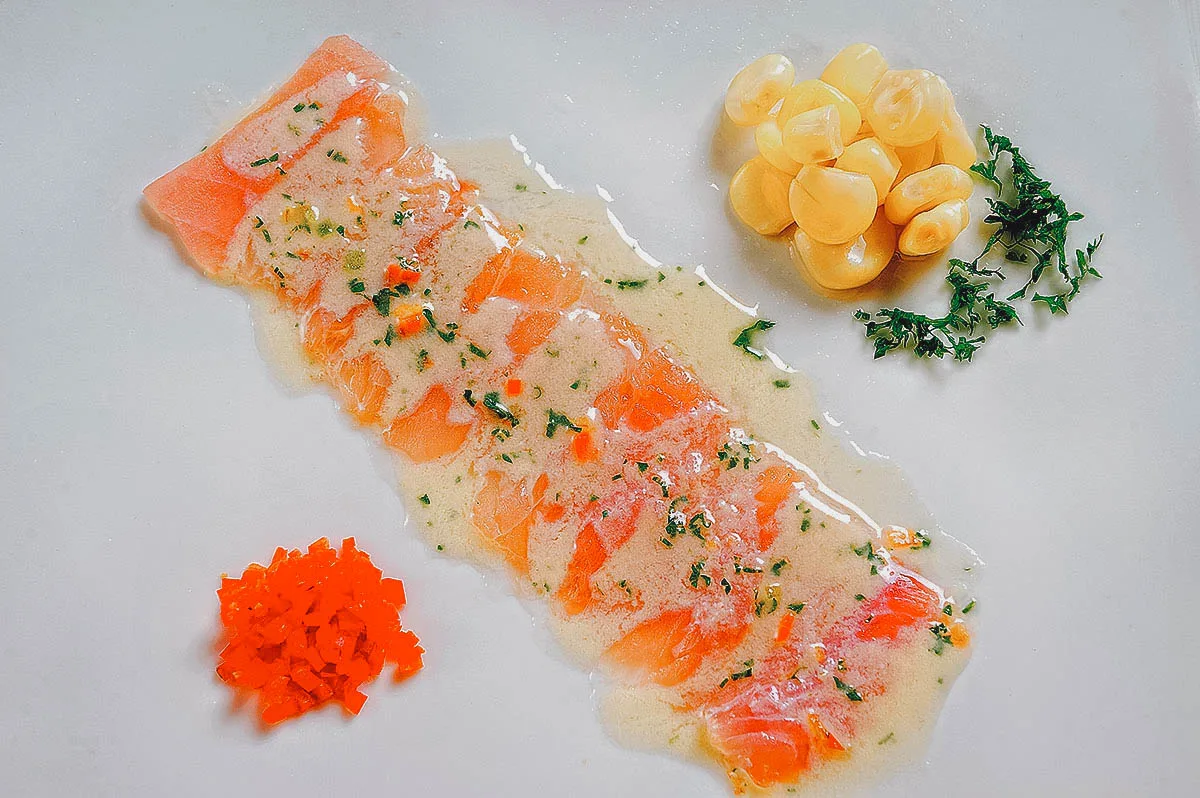
Photo by danielsanmartin
3. Leche de Tigre
Leche de tigre refers to a milky Peruvian drink made from lime juice, fish juice, onions, chili pepper, coriander, salt, and pepper. It’s an acidic, spicy, creamy, and invigorating drink often served in a small glass alongside Peruvian ceviche. It’s believed to be a hangover cure and aphrodisiac, hence the libidinous name leche de tigre, meaning “tiger’s milk”.
Originally, this milky drink was enjoyed as the leftover marinade from ceviche. Peruvians would spoon the leftover liquid after consuming the fish. They enjoyed it so much that they started to make it on its own, as a drink, so they could have more of it.
Today, leche de tigre is enjoyed throughout Peru and comes in many variations. It can be made with pureéd fish to make it thicker and creamier, or milk to balance out the acidity of the lime juice. Some contain chunks of fish and shellfish while others are made with peppers like aji amarillo (yellow chili) or rocoto.
This invigorating assault on your taste buds can be enjoyed everywhere in Peru, from humble roadside stalls to the most expensive restaurants in Lima.
RECIPE: Leche de tigre
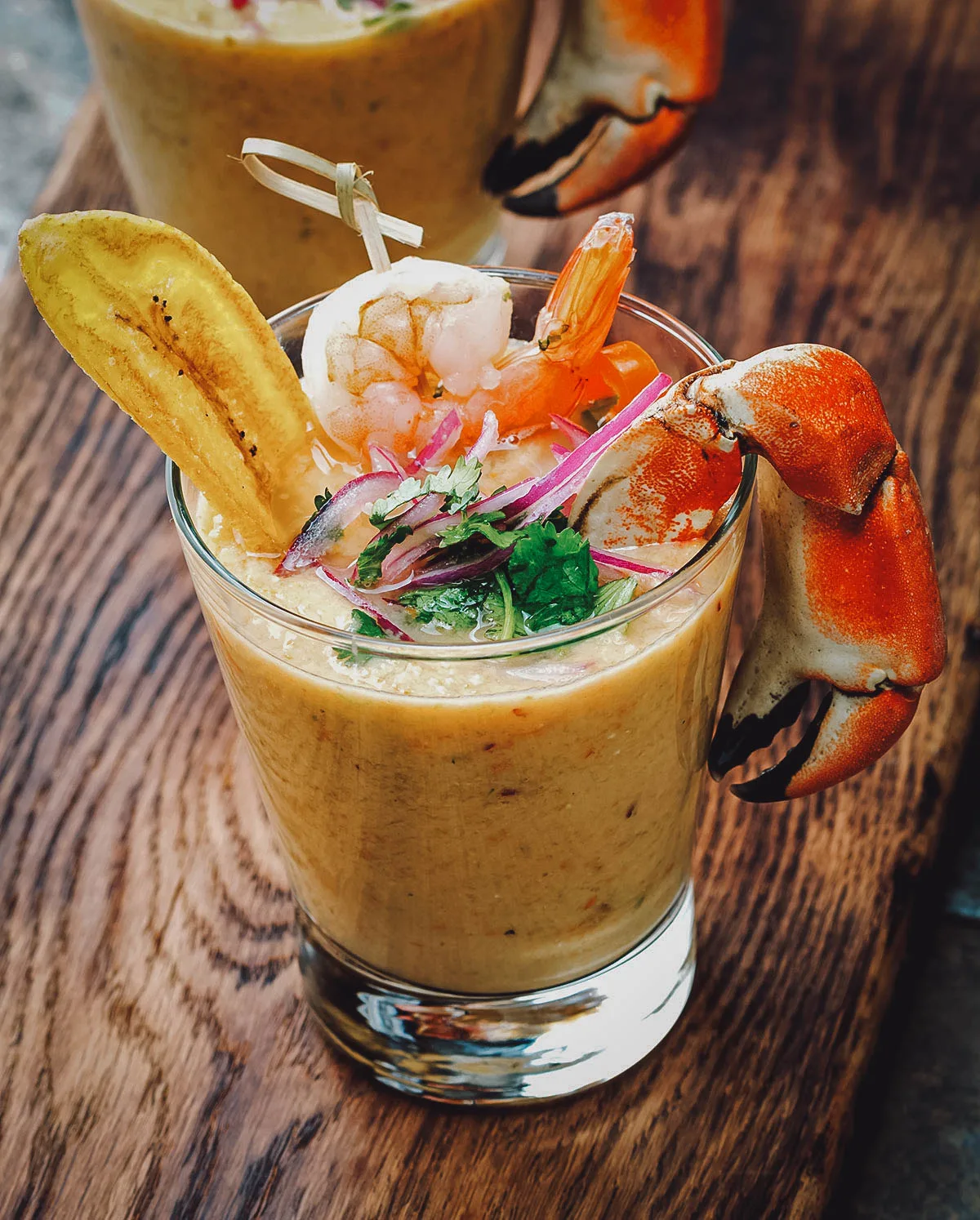
Photo by Blinovita
4. Chupe de Camarones / Langostinos
Chupe is the generic term used to describe a thick South American soup or stew. It’s especially popular in the cuisines of Peru, Chile, and Bolivia, and can be made with a variety of proteins like chicken, beef, fish, and seafood.
Chupe de camarones is a type of spicy Peruvian chupe made with crayfish, rocoto pepper, potatoes, vegetables, milk, and a poached egg. It’s originally from Arequipa in the southern coastal region of Peru. It’s traditionally made with crayfish but it can be made with shrimp as well (chupe de langostinos).
RECIPE: Chupe de camarones
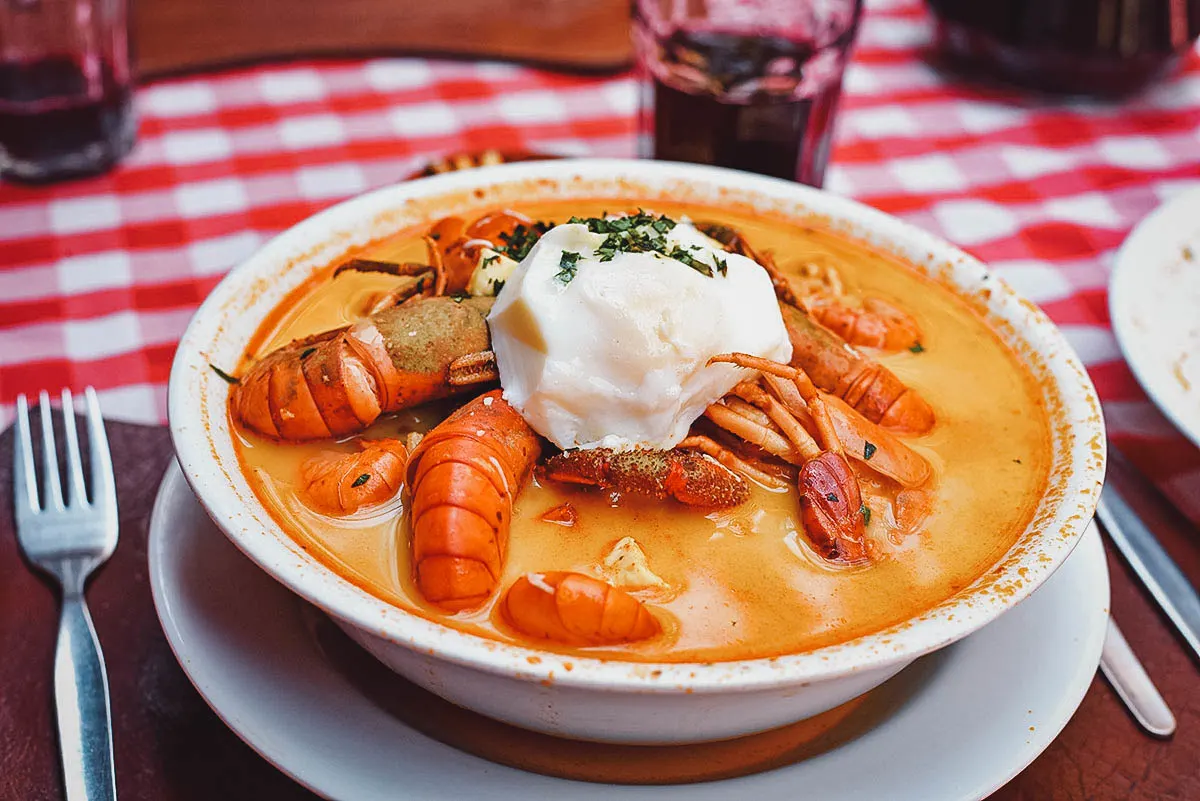
Photo by marktucan
MEAT
5. Lomo Saltado
Like ceviche, lomo saltado is one of the most popular and beloved Peruvian foods. It’s a great example why Peruvian food is often described as being one of the world’s truest fusion cuisines.
Lomo saltado refers to a stir-fry dish made with marinated strips of steak (usually sirloin), french fries, onions, aji amarillo, soy sauce, herbs, and spices. Lomo saltado is typically eaten with fried or white rice and is one of the best examples of Chinese-Peruvian fusion cooking.
In the late 19th and early 20th centuries, thousands of Chinese nationals from the province of Guangdong in East Asia immigrated to Peru to work in agriculture. After their contracts ended, most would settle in Lima and along the coastal regions of Peru.
The first Chinese-Peruvian restaurants would open shortly after in Lima’s Chinatown. They introduced the wok and the concept of stir-fry cooking to Peruvian cuisine, giving birth to fusion dishes like lomo saltado and arroz chaufa. These restaurants, along with the type of food they served, were referred to as “chifa”. It’s unclear where the word chifa came from but it may be derived from a Chinese term meaning “to eat rice”.
Chifa quickly caught on and became an important part of Peruvian cuisine. Like arroz chaufa, lomo saltado is one of the tastiest and most well-known examples of chifa cooking in Peru.
RECIPE: Lomo saltado
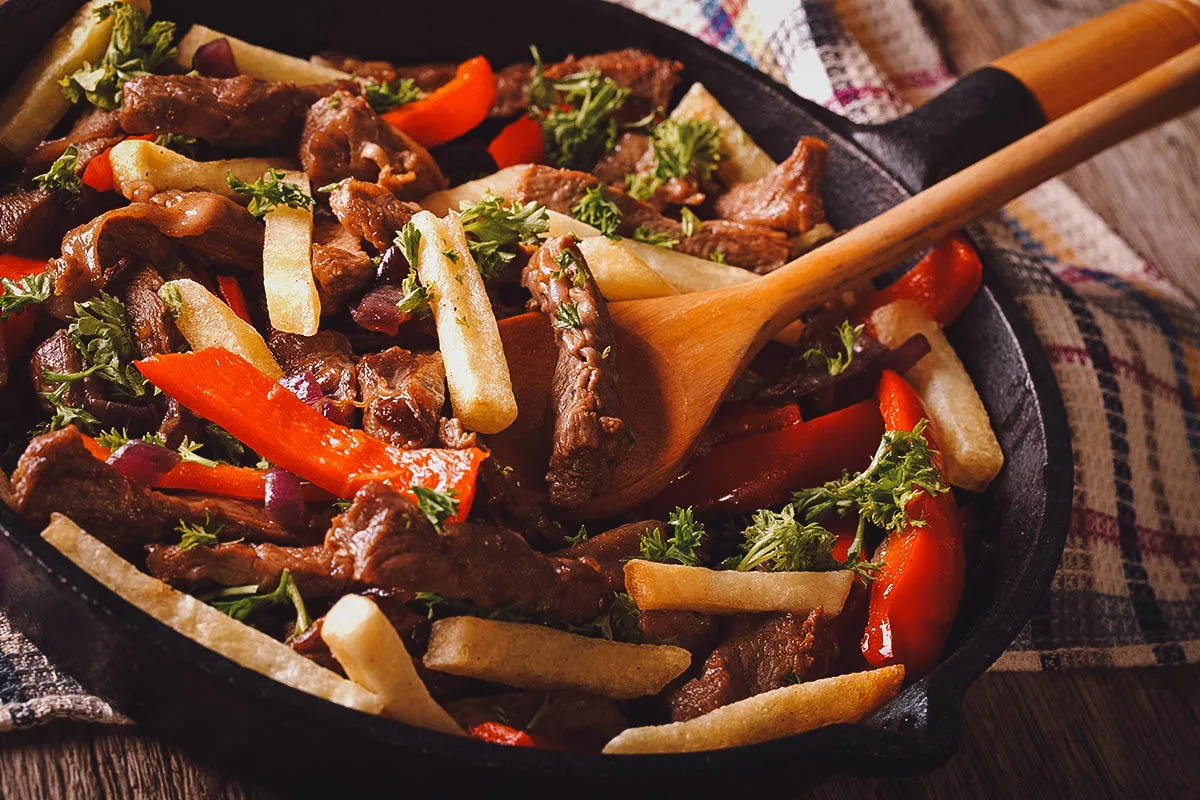
Photo by lenyvavsha
6. Cuy Frito / Cuy Chactado / Cuy a la Piedra
For outsiders, cuy is one of the most curious dishes in Peruvian cuisine. It refers to the guinea pig or cavy, a type of rodent found in the Andean Mountains of South America. While guinea pigs are kept as pets in western society, in South American countries like Peru, Bolivia, and Ecuador, they’re raised as livestock.
Cuy are domesticated for their meat which has been likened to rabbit or dark chicken meat. Because of their small size and rapid reproduction rates, they’re easy to keep as livestock and can be farmed even in urban environments. They’re known for being high in protein and low in fat and cholesterol.
Cuy are typically grilled, fried, or roasted. The term cuy chactado refers to guinea pig that’s been cooked under a stone. The guinea pig is deep-fried under the weight of a stone which doubles as a frying lid.
It’s estimated that 65 million guinea pigs are consumed in Peru every year. They’re a common ingredient in pachamanca and are celebrated in the annual religious festival known as jaca tsariy (“collecting the cuys”). In fact, they’re so ingrained in Peruvian culture that a famous painting in Cusco’s main cathedral depicts Jesus and the twelve disciples feasting on cuy.
RECIPE: Cuy frito
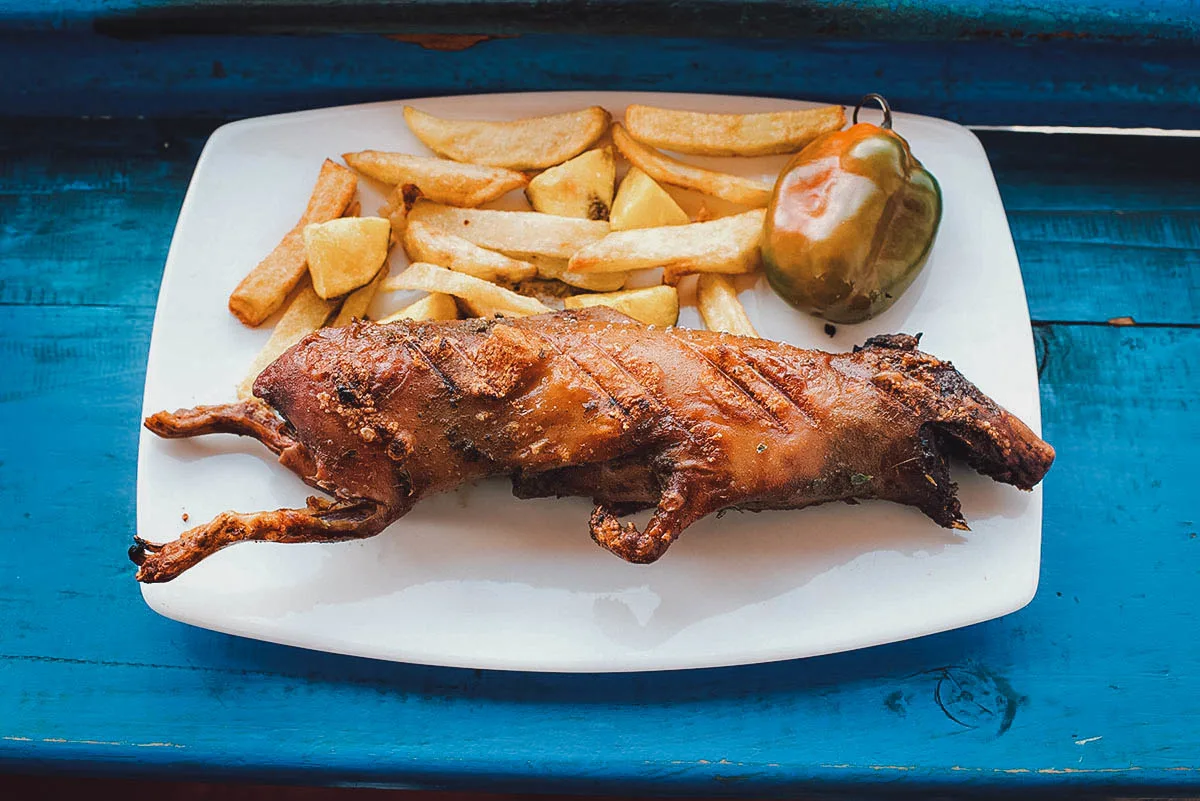
Photo by STYLEPICS
7. Anticuchos de Corazón
Anticuchos refers to skewered and grilled meat dishes. They’ve existed in the Andes region since pre-Columbian times, but modern versions of the dish are now widely consumed throughout South America.
In Peru, anticuchos are commonly sold from street carts and street food stalls known as anitcucheras. They can be made with any type of meat marinated in vinegar and spices like garlic, cumin, black pepper, and aji chilies, though the most popular version is made from beef heart (anticuchos de corazón). Anticuchos de corazón are typically served with boiled potatoes, corn, and sauces made from aji pepper.
Anticuchos in Peru can be traced as far back as the 16th century. At the time, they were made with llama and alpaca meat. Spanish conquistadores who encountered the dish replaced them with beef and introduced garlic into the recipe.
RECIPE: Anticuchos de corazon
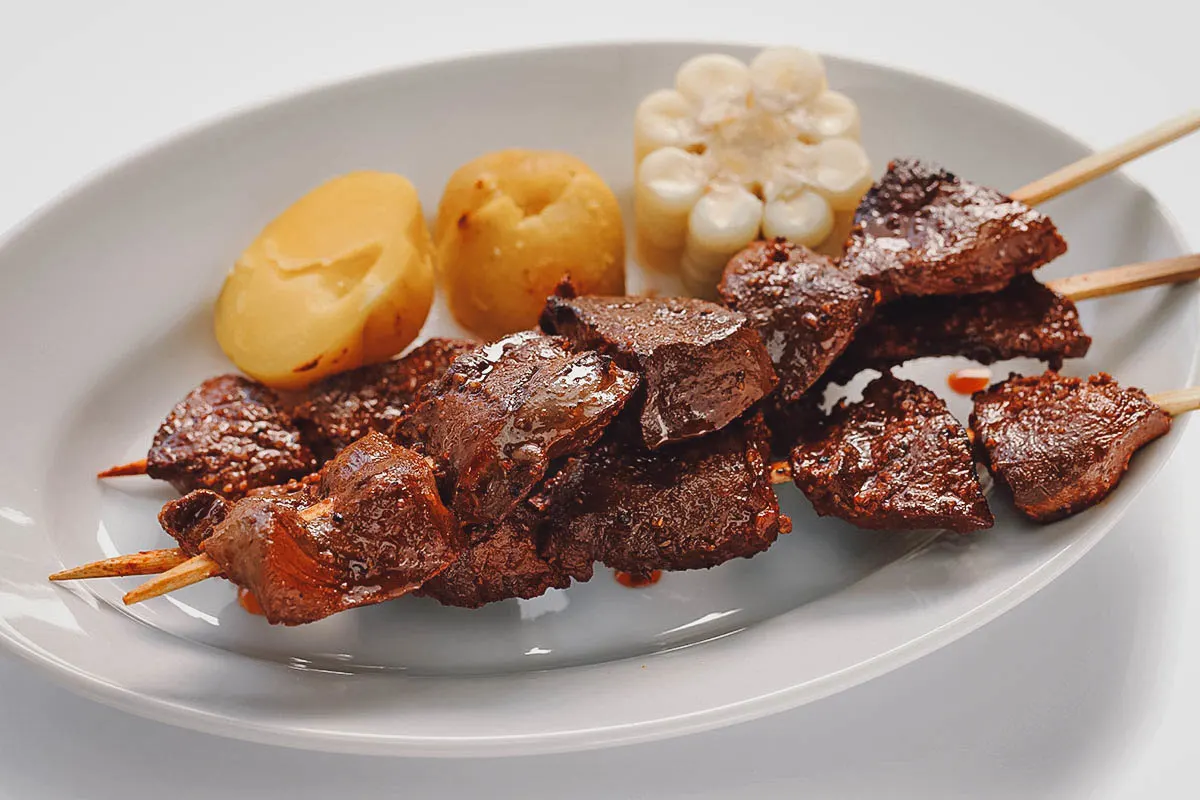
Photo by asimojet
8. Empanada
Empanada is a type of baked or fried turnover common in the cuisines of many countries in Central and South America, including Peru. Recipes vary but it’s typically made with dough folded over a filling of meat, vegetables, potatoes, egg, raisins, spices, and other ingredients. The name empanada stems from the Spanish word empanar, meaning to “roll in pastry dough”.
Empanadas are a popular street food in Peru. They can be baked or fried and usually made with minced beef, olives, and hard-boiled egg. Other common ingredients include onions, chives, garlic, cumin, coriander, and pepper.
RECIPE: Peruvian empanadas
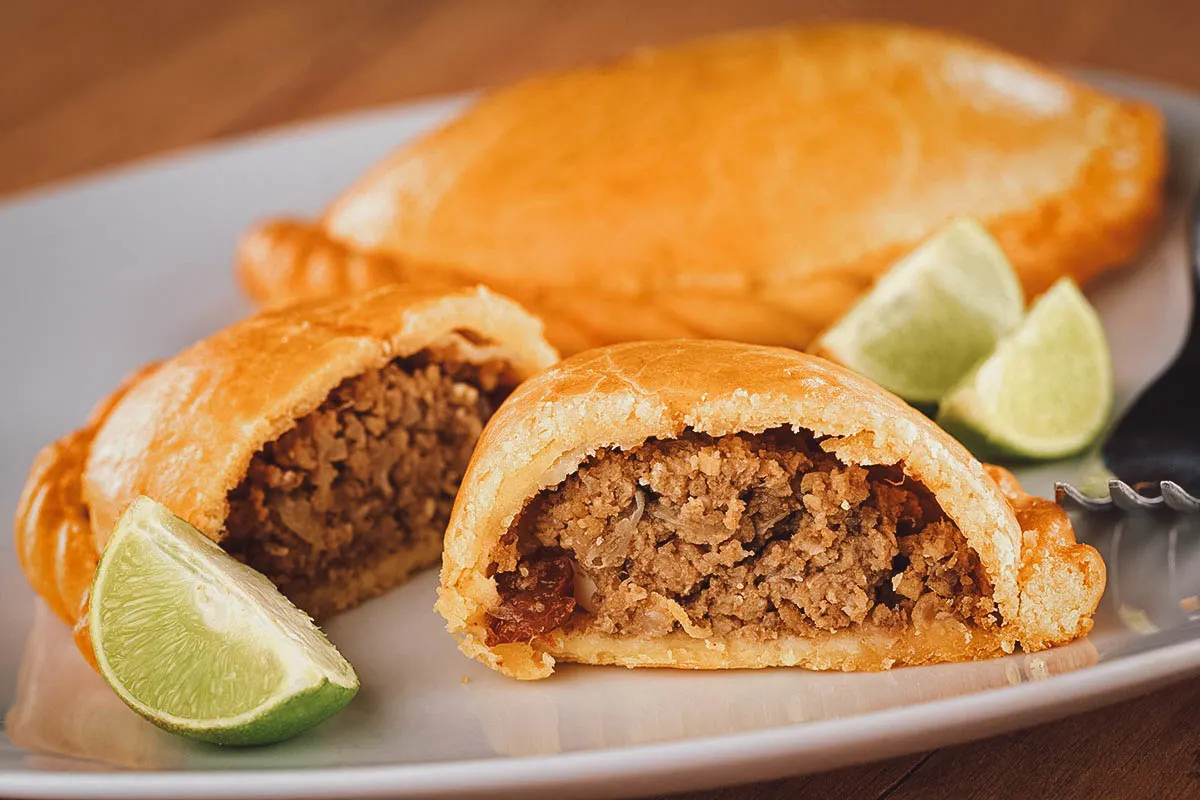
Photo by ildi_papp
9. Lomo a lo Pobre
Lomo a lo pobre refers to a Peruvian and Chilean dish made with steak topped with fried eggs and served with a side of fries. Unlike steak and eggs which is typically a breakfast dish, lomo a lo pobre is usually consumed for lunch or dinner.
Pobre means “poor” but it’s unclear how this dish got its name. One of the most popular theories speculates that lower-income families in Lima were known to eat meat with eggs, rice, and other carbohydrates, while upper-class families enjoyed steak only with vegetables. Today, it’s consumed by all classes in Peru with no negative stigma attached to the dish.
RECIPE: Lomo a lo pobre
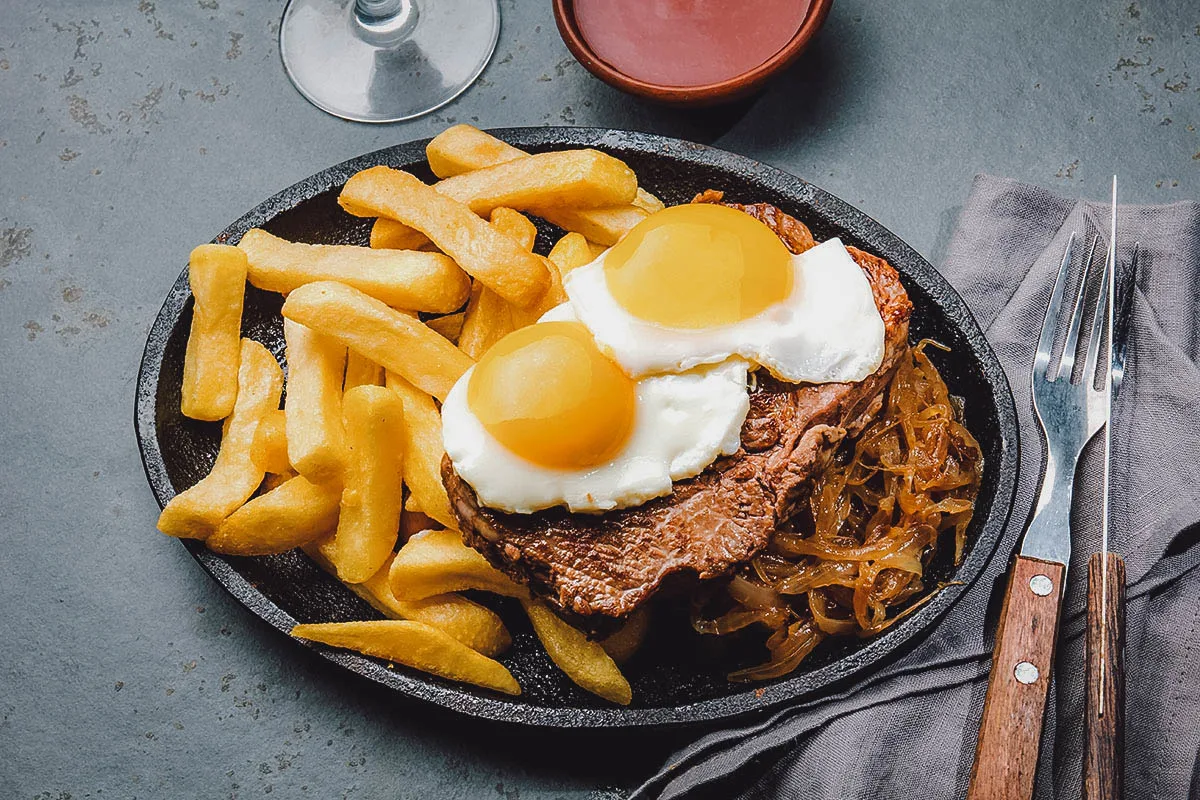
Photo by Blinovita
10. Pachamanca
Pachamanca refers to a traditional Peruvian dish cooked with hot stones over an earthen oven called a huatia. It consists of meat and tubers buried in a pit with river stones heated by a wood fire. It’s a culturally significant dish and cooking method that’s existed since the time of the Incan Empire.
Pachamanca is typically made with a variety of meats like cuy, llama, alpaca, mutton, lamb, beef, pork, and chicken marinated in different herbs and spices. They’re wrapped in marmaquilla or chincho leaves before being buried and cooked in the huatia for about 40 minutes to 1.5 hours. Different potato varieties and other root crops like cassava, corn, plantains, habas (lima bean pods), and chili peppers are often added and cooked with the meats.
Historically, pachamanca was made primarily within three regions in the central Peruvian Andes – the upper Huallaga valley, the Mantaro valley, and Ayacucho. Today, its consumption is more widespread throughout Peru with different regions developing their own recipes for the dish. Meats and ingredients may differ but the cooking method and spices used remain mostly the same.
Declared a part of Peru’s National Cultural Heritage, pachamanga is an important Peruvian dish that’s usually reserved for special occasions.
RECIPE: Pachamanca a la olla
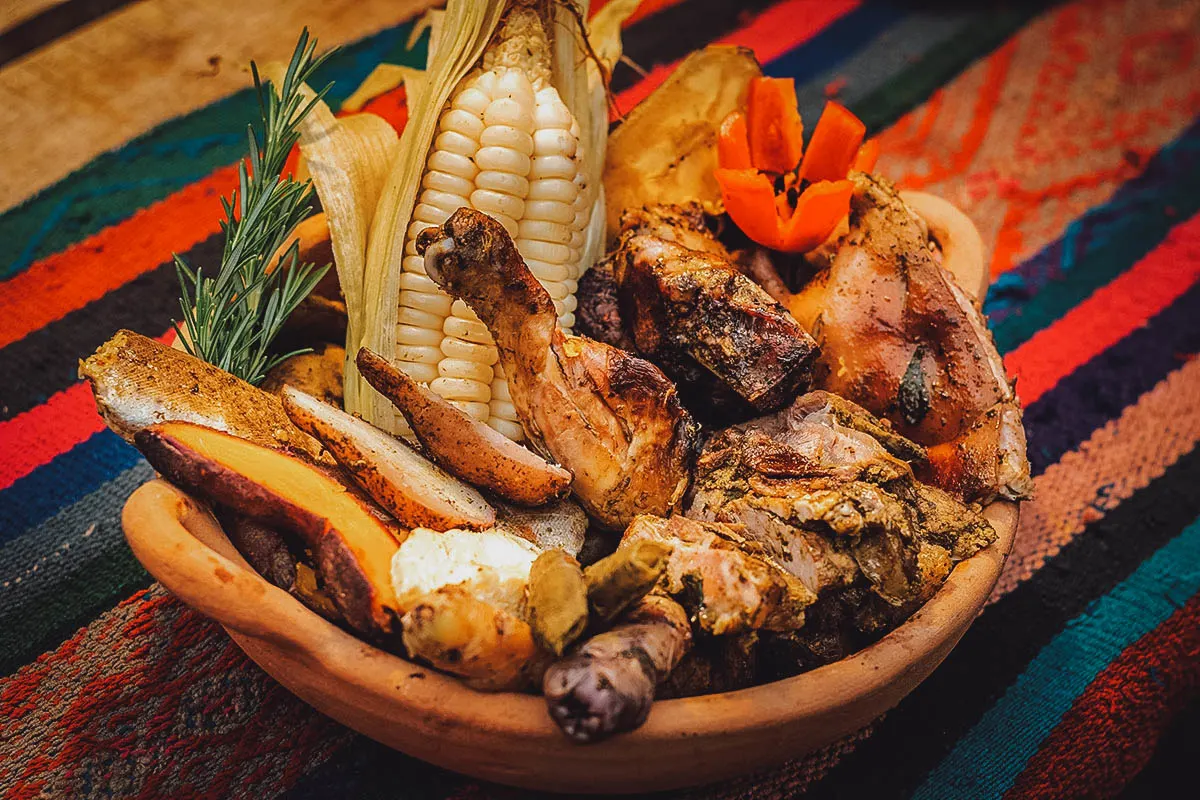
Photo by a35mmporhora
11. Salchipapas
Salchipapa refers to a hugely popular Peruvian street food dish that first appeared on the streets of Lima. It’s made with thinly sliced pan-fried beef sausages served with french fries. It’s usually served with ketchup, mustard, and aji sauce along with garnishes like a fried egg, cheese, lettuce, and tomatoes.
Salchipapa is a portmanteau word for salchicha (sausage) and papa (potatoes). It’s originally from Peru though it’s become popular in other Latin American countries as well like Ecuador, Bolivia, Colombia, and Argentina.
RECIPE: Salchipapas
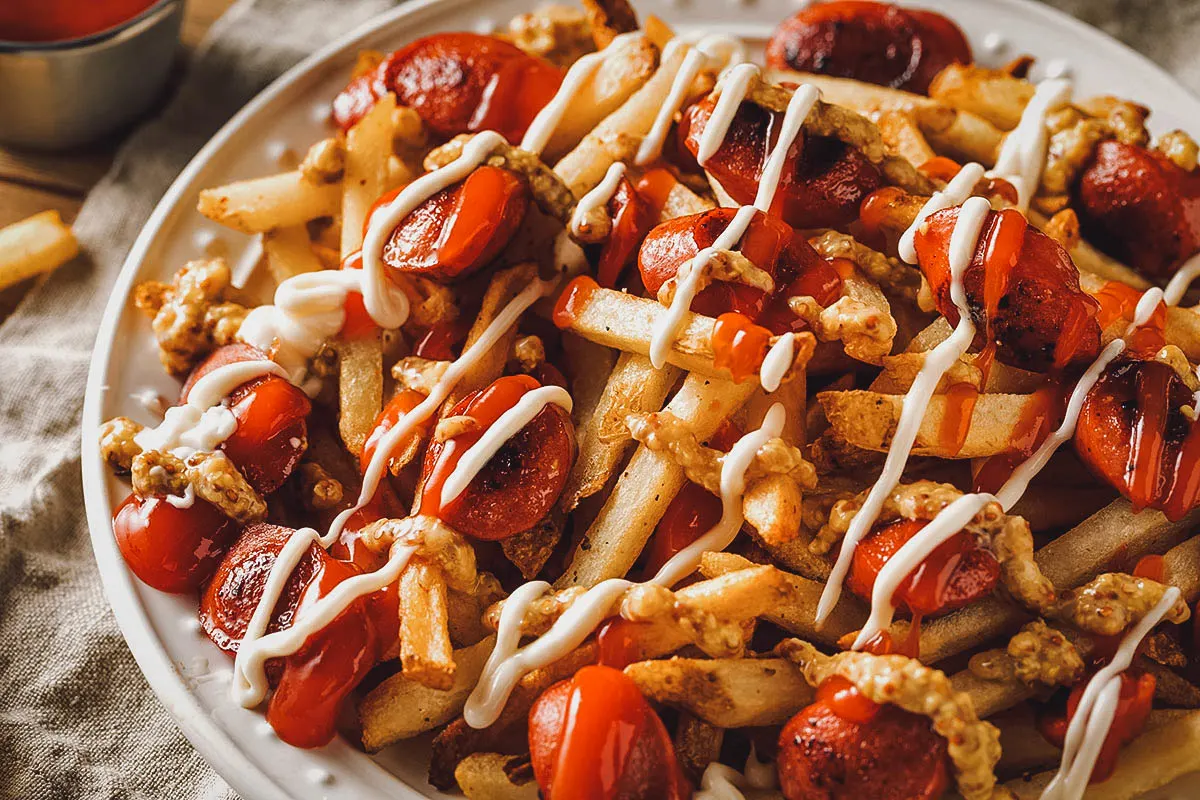
Photo by bhofack2
12. Chicharron
Chicharron refers to fried pork belly or pork rinds. It’s a popular dish that’s widely consumed throughout the Americas and the Philippines.
Chicharron is a dish of Spanish origin. Before the mass production of vegetable oil, people used to cook with animal fat so they’d fry the pork in its own fat to extract the lard for future use. The leftover pieces of fried pork would become chicharron.
However, chicharron is a little different in Peru. The crunchy rind and attached fat typically isn’t used. Instead, the pork is boiled with seasonings and then fried in its own fat.
Chicharron is so popular in Peru that you’ll find many restaurants called chicharronerías specializing in the dish. One of the most popular Peruvian dishes made with fried pork is pan con chicharron.
Pan con chicharron exists in many variations throughout Peru but the most traditional Lima version is made with slices of fried sweet potato and a spicy onion and chili pepper relish known as sarsa criolla. It’s traditionally served in a soft bread roll called pan francés and usually eaten for breakfast.
RECIPE: Pan con chicharron
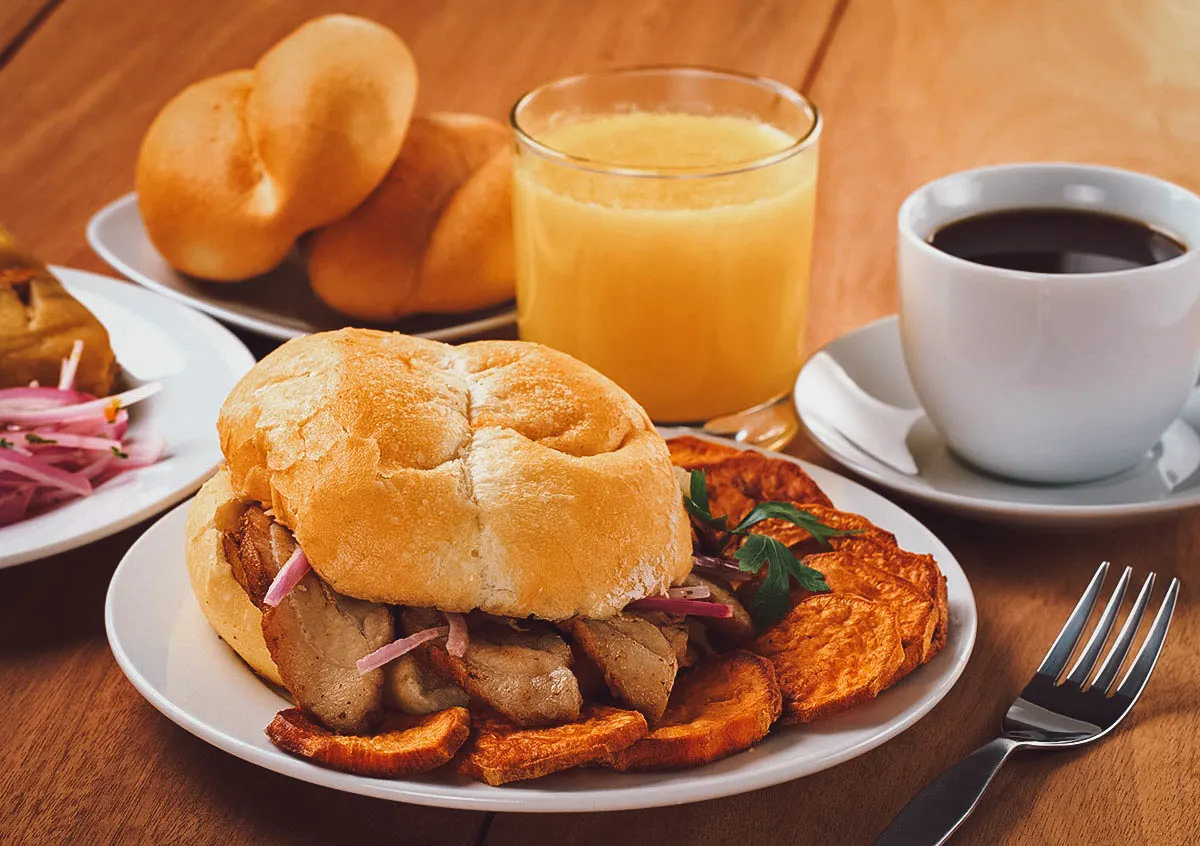
Photo by ildi_papp
In Peru, chicharron can also refer to fritters made with fish, seafood, or chicken. Fish fritters are known as chicharron de pescado. They’re often served at cevicherias with a side of salsa criolla and aji amarillo, rocoto, or tartare sauce.
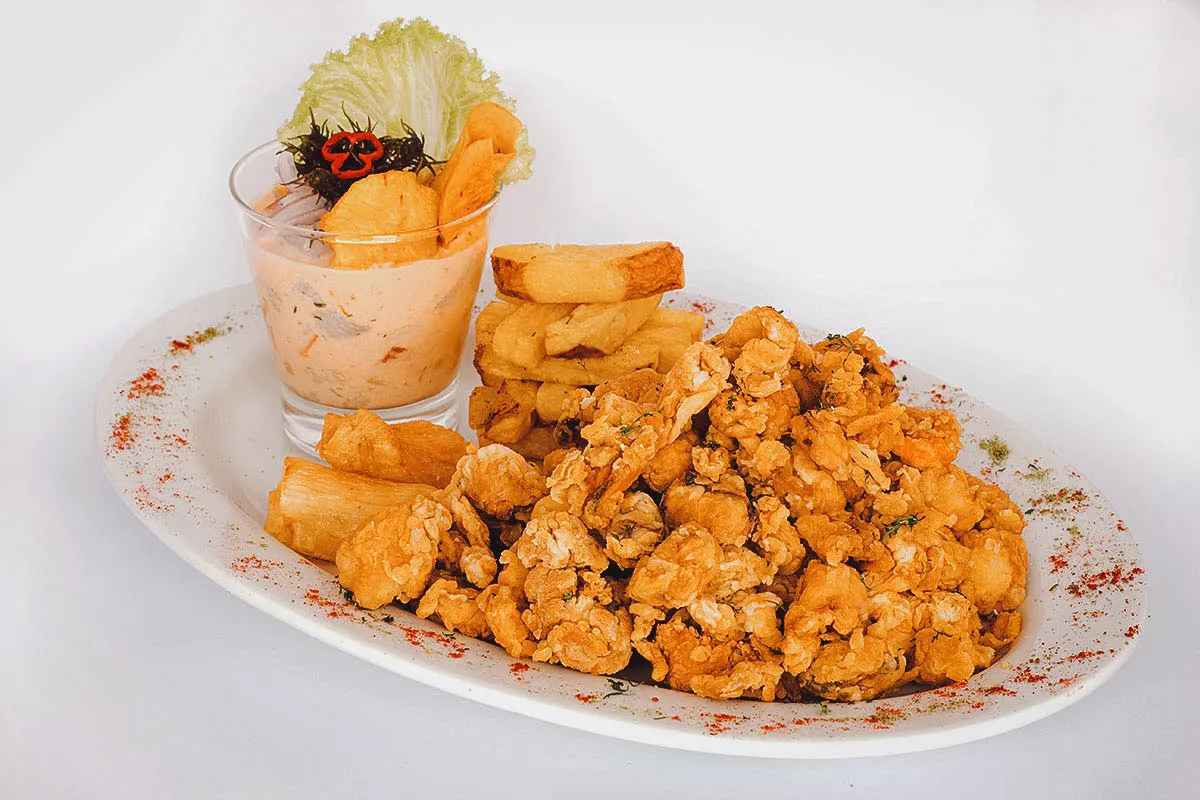
Photo by mirceadobre78
13. Carapulcra
Carapulcra is an ancient Peruvian dish that’s been prepared by the Quechua and Aymara people of the Andes for centuries. It refers to a pork stew made with dried potatoes, diced pork, ground peanuts, aji panca (red aji), mirasol peppers, garlic, and spices.
Carapulcra’s name in the Aymara language is qala phurk’a, meaning “stew made with hot stones”. This is in reference to the way the pork stew is cooked in a clay pot over special pre-heated cooking stones. Because of its ancient origins, it’s believed that carapulcra was originally made with llama or alpaca meat before Spanish conquistadores changed it to pork.
Aside from the way it’s cooked, what makes carapuclra interesting is that it’s made with papa seca or dehydrated potatoes. Using a centuries-old process, Andean people would dice boiled potatoes before laying them out in the harsh Andean sun to dry. This served as a preservation method that also changed the flavor and texture of the potatoes.
According to some sources, carapulcra had been looked down upon by members of Peru’s upper classes for decades, but it’s now a dish enjoyed across all socioeconomic classes in Peru.
RECIPE: Carapulcra
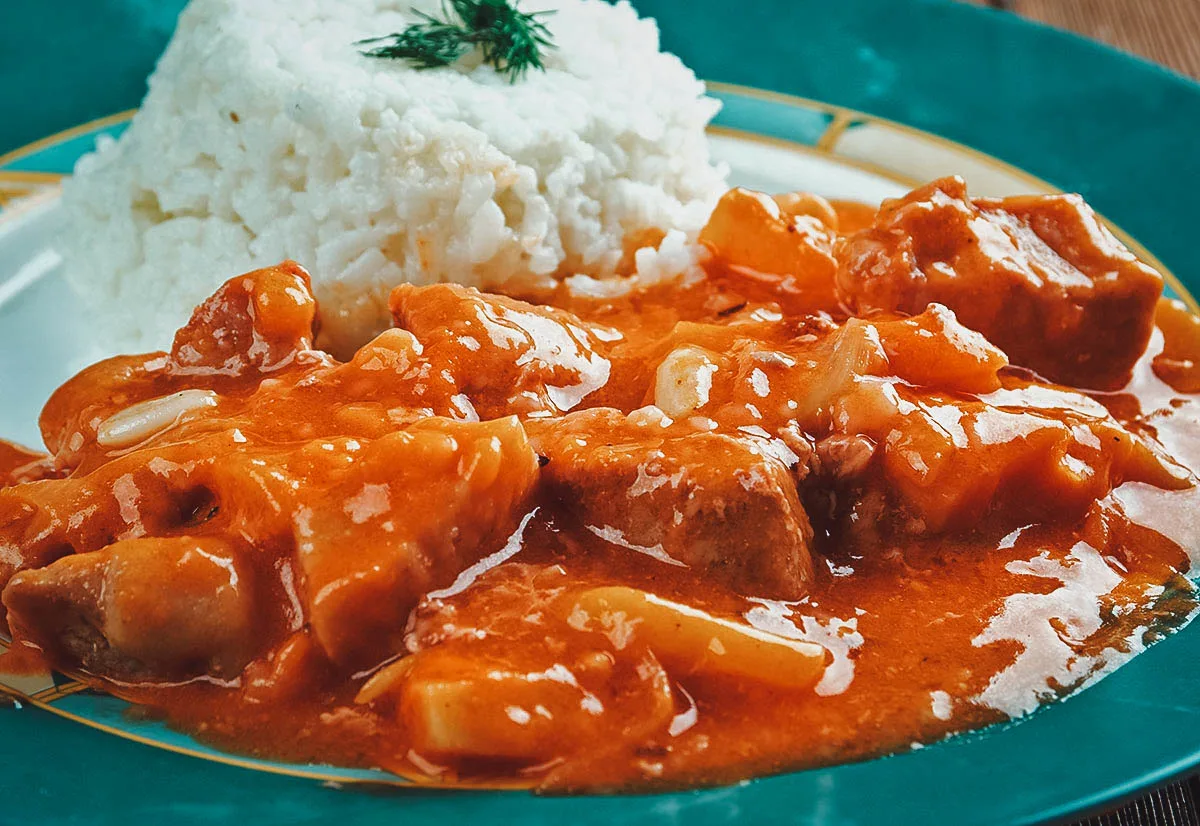
Photo by fanfon
POULTRY
14. Pollo a la Brasa
Pollo a la brasa is an immensely popular roast chicken dish from Peru. In fact, it’s one of the country’s most popular dishes along with ceviche, salchipapas, and chifa. Available at rotisserie chicken restaurants called pollerías, it refers to spit-roasted chicken that’s usually served with thick-cut french fries, salad, and condiments like aji sauce, ketchup, mustard, and mayonnaise.
Pollo a la brasa is a relatively recent creation that was invented sometime in the 1950s by Roger Schuler and Franz Ulrich, two Swiss nationals who were residing in Peru. Schuler settled in the town of Santa Clara, just outside Lima, where he started breeding chickens.
He roasted some of the chickens and began offering them to the public on an all-you-can-eat basis at a low cost. Easy on the taste buds and your wallet, the concept took off which inspired him to open a restaurant – La Granja Azul – which continues to stand at the very same spot to this day.
At first, his chef would spit-roast the chickens by hand, but in order to meet growing demand, an acquaintance would build him the first ever pollo a la brasa rotisserie oven. By the 1990s, pollerías were everywhere in Peru.
The Peruvian government estimated that 371 million servings of pollo a la brasa were sold throughout the country in 2010 alone. That averages to about one serving of roasted chicken for every Peruvian per month!
Pollo a la brasa has become popular in the cuisines of Brazil, Colombia, and Venezuela as well.
RECIPE: Pollo a la brasa
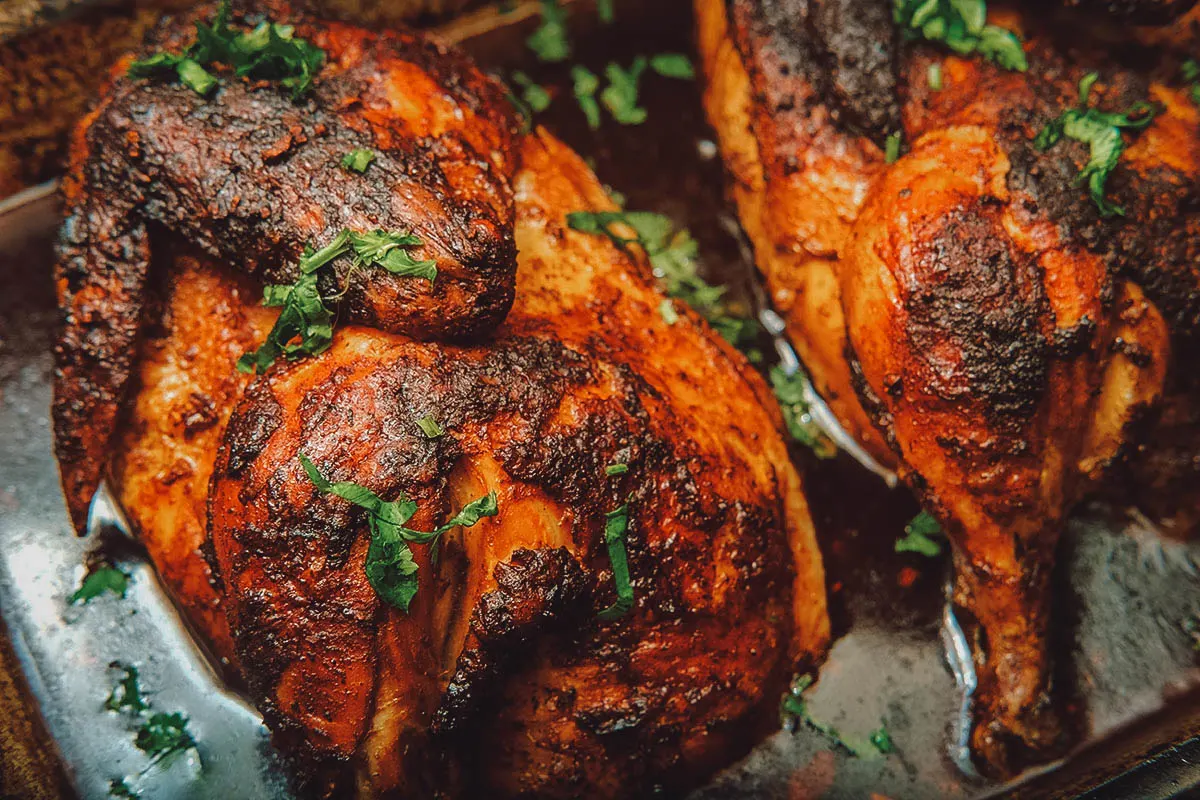
Photo by ezumeimages
15. Arroz con Pato
If you like arroz con pollo, then you’ll probably enjoy arroz con pato as well. Literally meaning “rice with duck”, it’s a popular duck and rice dish from Chiclayo, a city north of Lima.
Arroz con pato is very similar to arroz con pollo and is known for its rice that can range from a muted to an intense green in color. The rice gets its color from a generous helping of cilantro.
To make arroz con pato, the duck is lightly fried for a few minutes before being cooked with some broth, beer, and pisco, a type of grape brandy made in Peru. It’s then served with the cilantro rice and a side of salsa criolla.
RECIPE: Arroz con pato
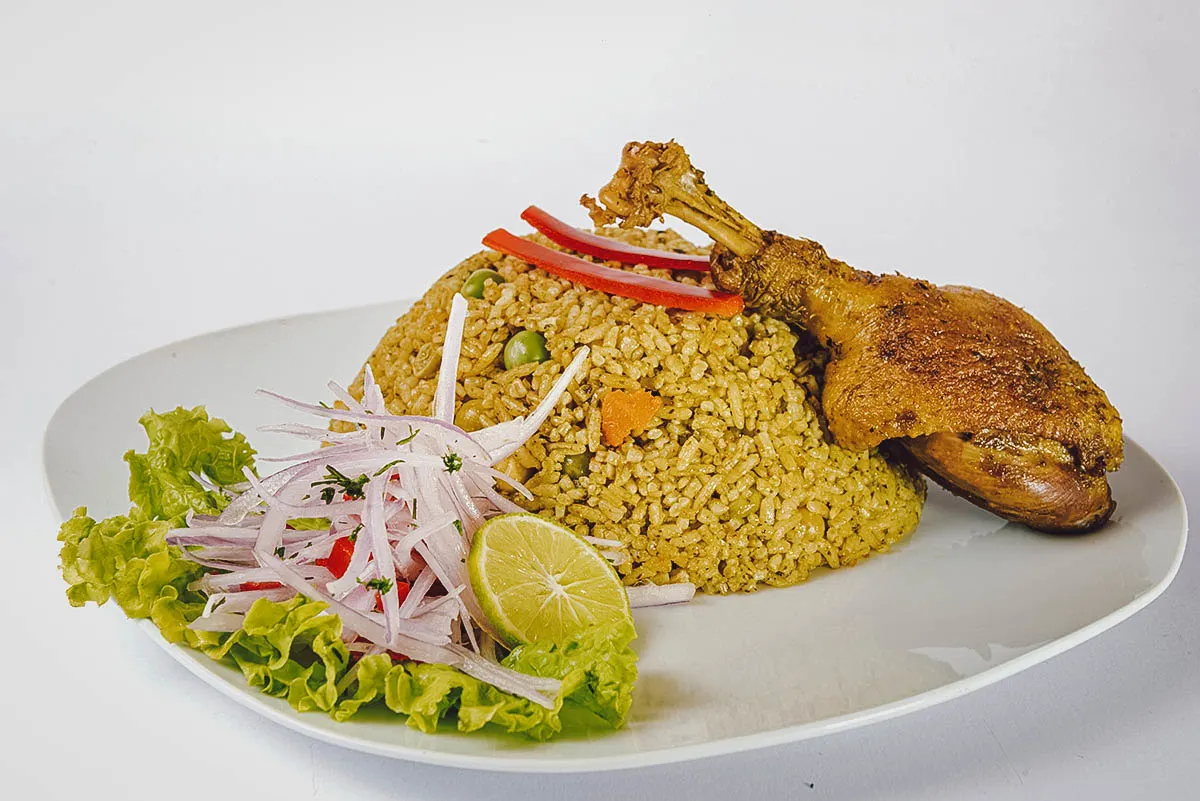
Photo by Wirestock
16. Aji de Gallina
Aji de gallina refers to a spicy and creamy chicken stew. It’s made with shredded poached chicken smothered in a thickened stock made from aji amarillo, garlic, onions, milk-soaked bread, parmesan cheese, and ground walnuts or pecans. Aji de gallina is a comforting Peruvian dish that’s usually served with white rice and garnished with olives and hard-boiled egg.
Traditional recipes for aji de gallina use older hen meat (gallina). However, old hens are tougher and take longer to cook so people started using regular chicken meat instead.
RECIPE: Aji de gallina
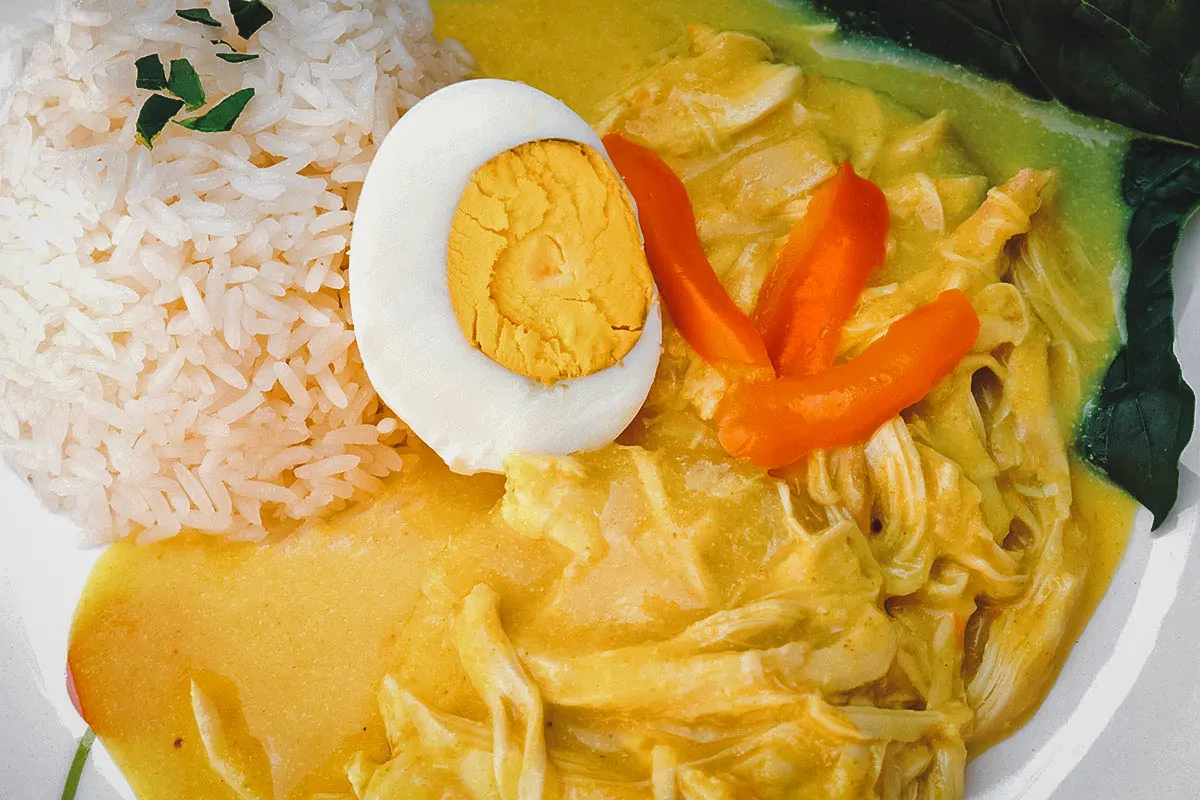
Photo by Wirestock
17. Caldo de Gallina
Caldo de gallina is a type of Peruvian chicken noodle soup. It’s a boldly flavored soup that’s often enjoyed in the morning as a hangover cure.
To prepare, potatoes and old stewing hens are boiled for hours to create a rich and starchy soup. Gallina is preferred because they can stand up to the long boiling process better than young chickens, which tend to disintegrate and dry out.
When ready, the soup can be seasoned with chili peppers, chives, and a spritz of Peruvian lime for even more flavor.
RECIPE: Caldo de gallina
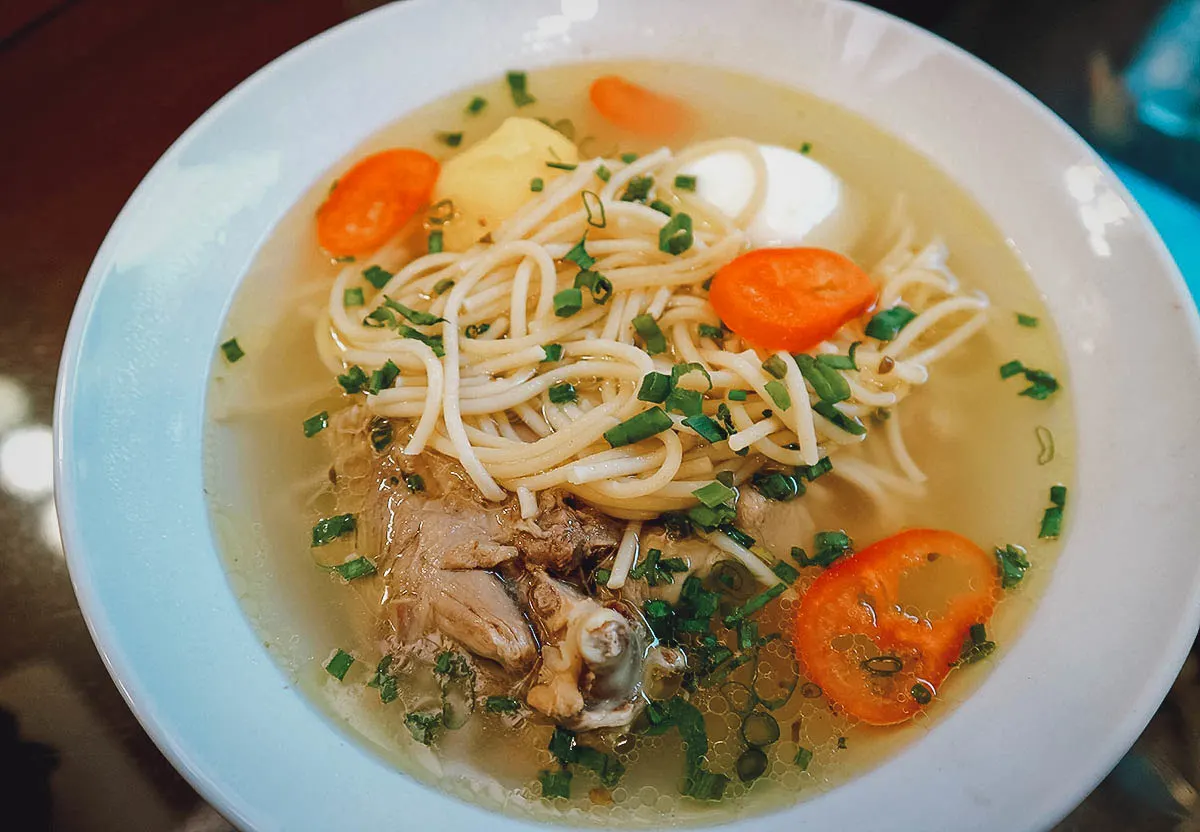
Photo by shinylion
18. Juane
Juane refers to a traditional dish from the jungles of Peru. It’s sold wrapped in waxy bijao leaves that look like green money bags when unopened. When you cut the string at the top, the leaves unfurl to reveal a ball of sticky yellow rice inside.
Juane is made with gallina meat, black olives, hard-boiled eggs, and rice seasoned with various herbs and spices like turmeric, cumin, and oregano. It’s commonly sold at traditional restaurants and markets and often eaten with cassava or boiled bananas.
The dish is believed to get its name from Saint John the Baptist (San Juan) who’s recognized as the patron saint of the Amazon. During the annual Festival of San Juan on June 24, extra large juanes are traditionally served and eaten by the riverside.
Interestingly, the way the dish is packaged may be a reference to the severed head of Saint John, who was executed by Herod.
RECIPE: Juane de gallina
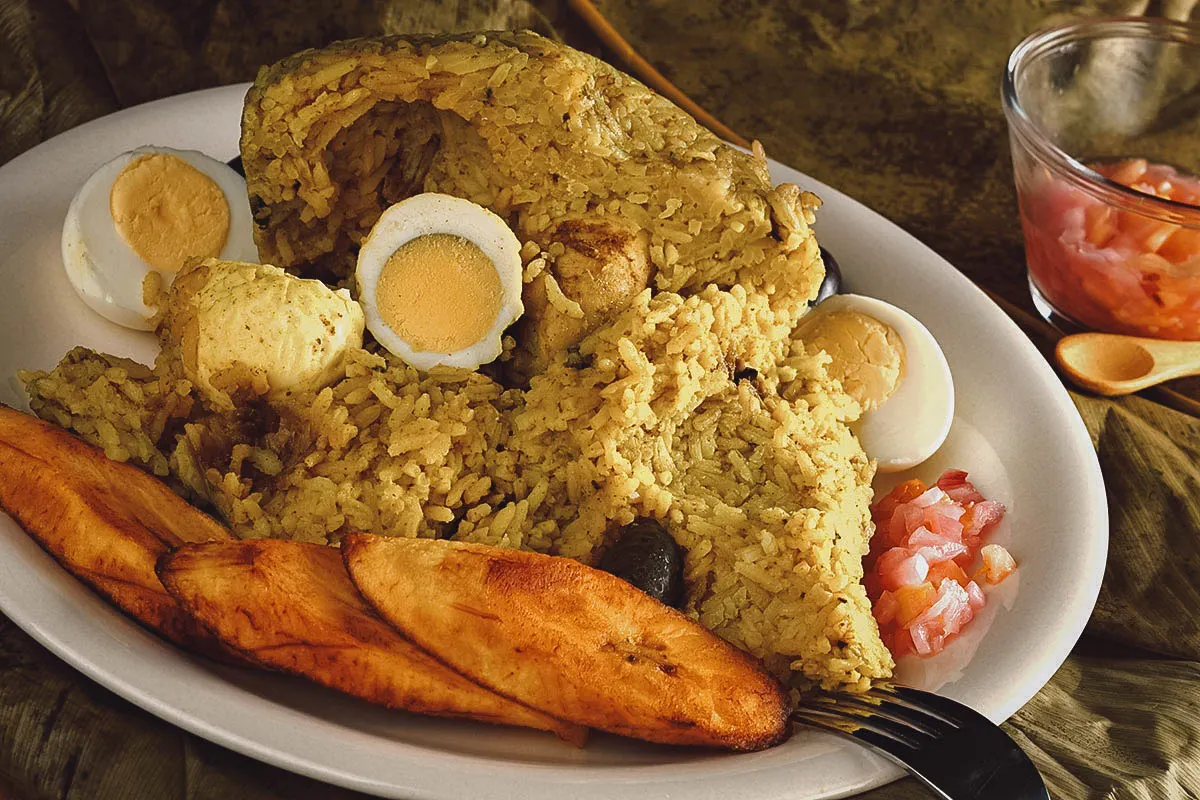
Photo by ildi_papp
VEGETABLES / GRAINS / TUBERS
19. Papa a la Huancaina
Papa a la Huancaina is a popular Peruvian appetizer of boiled yellow potatoes smothered in a creamy and spicy cheese sauce known as Huancaina sauce. It’s typically served cold over lettuce and garnished with black olives, hard-boiled egg, and parsley.
What makes this Peruvian potato dish special is the sauce. It’s made from queso fresco (fresh white cheese), aji amarillo, evaporated milk, vegetable oil, and salt. It can be made with other ingredients as well like garlic, onion, and crushed crackers that act as a thickener.
Papa a la Huancaina is named after Huancayo, a city in the Peruvian highlands, but it’s believed to have originated in Lima. Its exact origins are unclear but one theory claims that the dish was invented during the construction of Peru’s Central Railway. Huancan women preparing food for the workers would boil potatoes and serve them with a sauce made from cheese, milk, and pepper. This dish would catch on and eventually become known as papa a la Huancaina.
Another story asserts that a dish of potatoes smothered in a spicy cheese sauce may have been served at railway stations between Lima and Huancayo. It came to be known as “potatoes that you eat en route to Huancayo”, which would later become papa a la Huancaina.
RECIPE: Papa a la huancaina
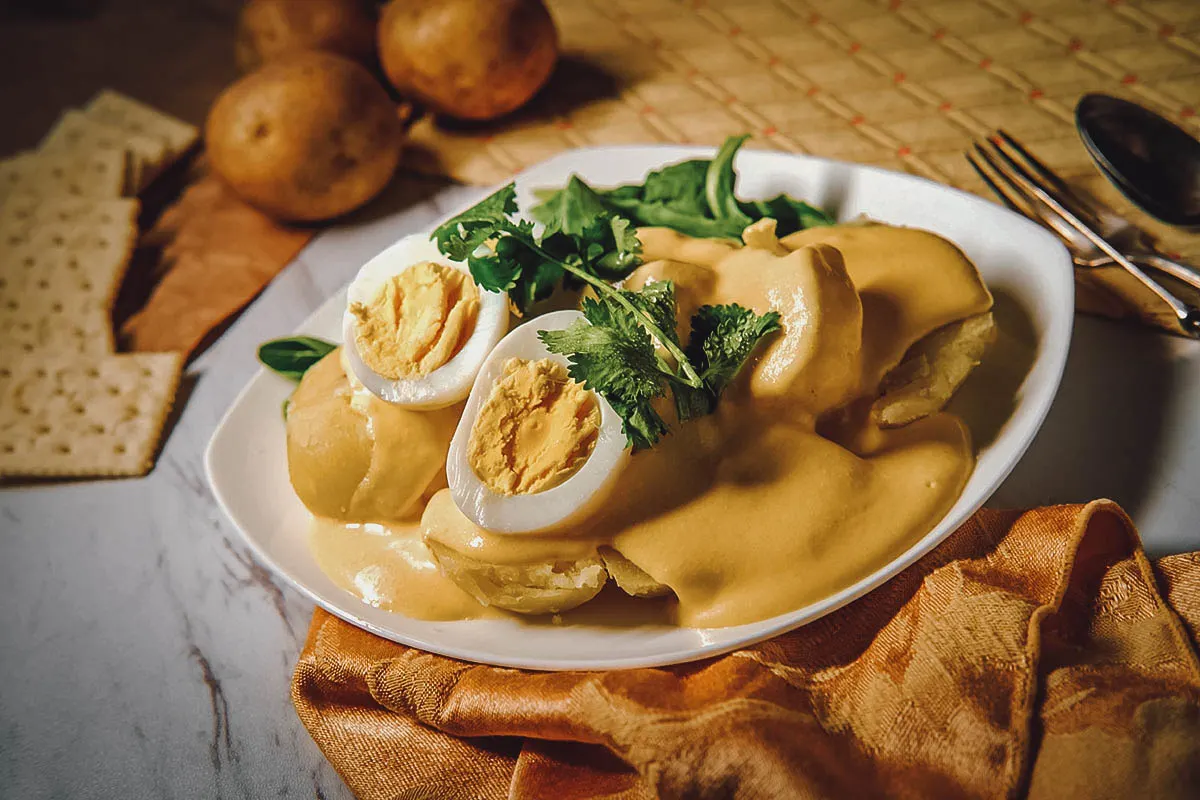
Photo by ezumeimages
20. Arroz Chaufa
Like lomo saltado, arroz chaufa is a hugely popular chifa dish. It refers to Peruvian-Chinese fried rice made with egg, vegetables, dark soy sauce, and some type of meat cooked in a wok at very high heat. The name chaufa is derived from the Chinese term chǎo fàn, meaning “fried rice”.
Recipes vary but arroz chaufu is typically made with beef, pork, chicken, or shrimp, but it can be made with other proteins as well like duck, fish, and jerky. Some versions are even made with alligator or lizard meat.
Whatever protein its made with, you should definitely order a plate of arroz chaufa with lomo saltado for the ultimate Peruvian chifa meal.
RECIPE: Arroz chaufa
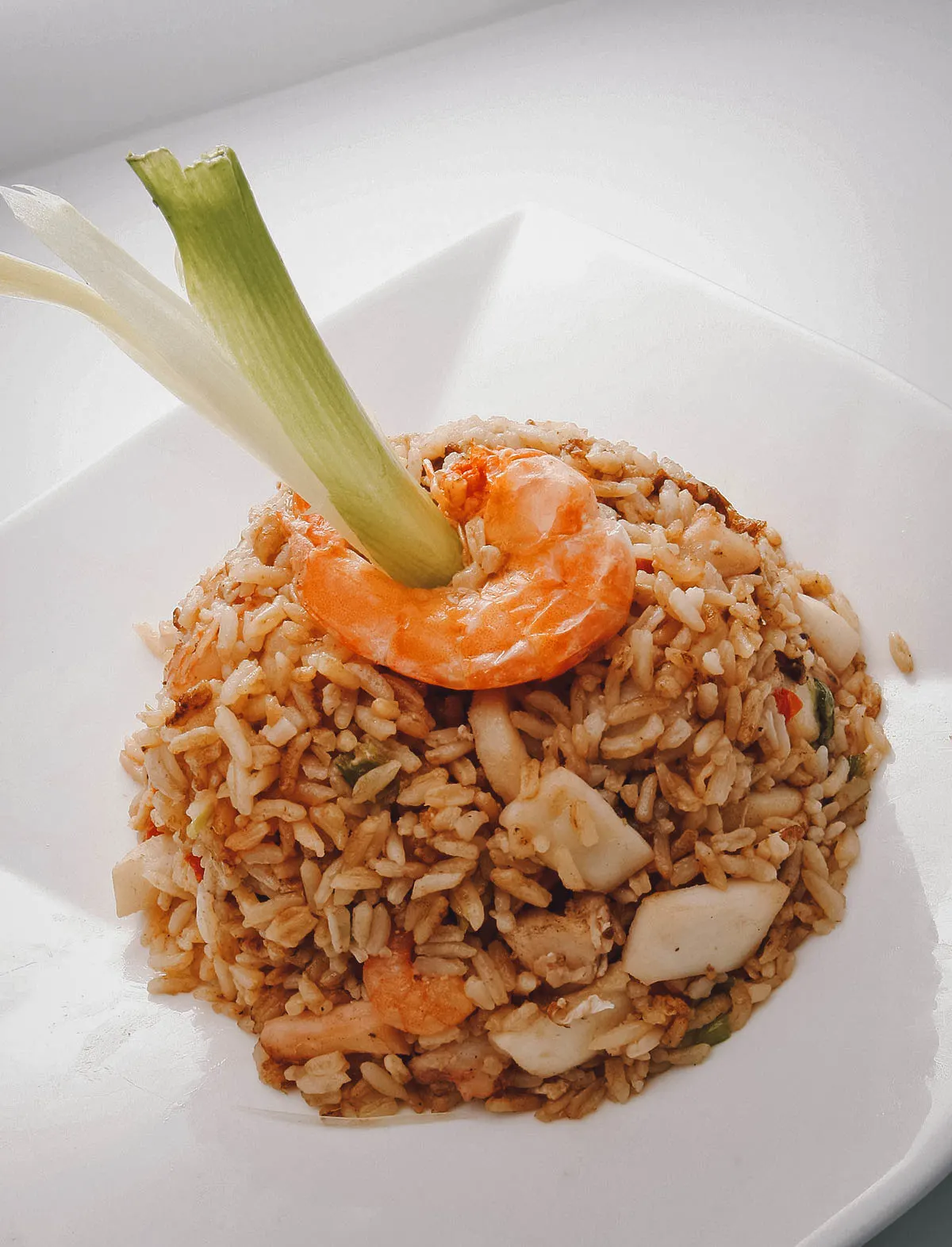
Photo by Redav
21. Tamales
The tamale is an ancient Mesoamerican dish enjoyed in many parts of the Americas, the Philippines, and Guam. It’s made with maza (maize dough) wrapped in a corn husk or banana leaf and filled with a variety of ingredients like meat, vegetables, cheese, fruit, and chili pepper.
Their exact origins are unclear but tamales may date back to as early as 8000 to 5000 BC. It’s believed that they spread from the indigenous cultures of Mexico and Guatemala to the rest of Latin America.
Tamales were a convenient and portable food that could be carried long distances. They were also considered sacred and played significant roles in festivals and rituals.
In Peru, there exist many different types of tamales. In Lima for example, tamales filled with chicken is popular. It’s typically eaten for breakfast with salsa criolla and coffee. Other common types of Peruvian tamales include creole tamales, serrano tamales, chinchano tamales, and Cajamarca tamales.
RECIPE: Peruvian tamales
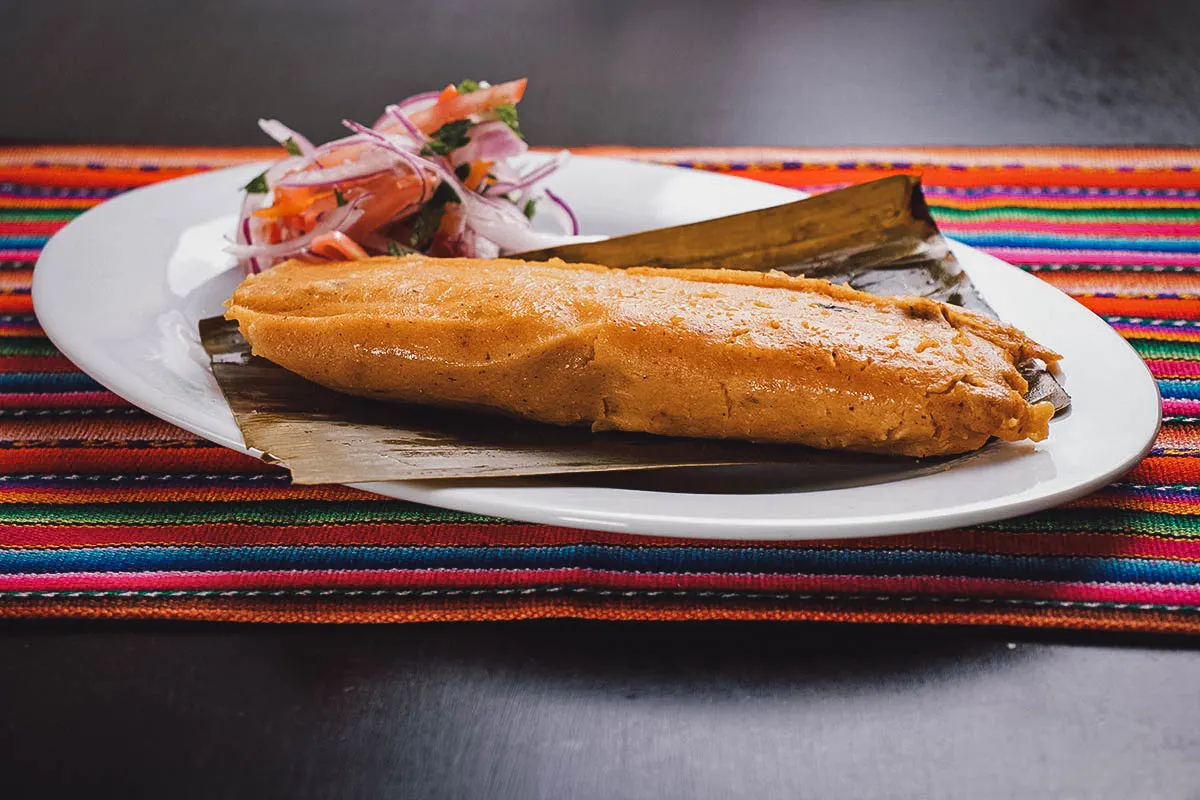
Photo by denismantilla
22. Causa Rellena
Causa rellena refers to a traditional Peruvian potato casserole dish made with mashed yellow potatoes, chicken or tuna, aji amarillo, avocado, mayonnaise, and lime juice. The mashed potato is typically molded into discs with the filling sandwiched in between.
Causa in Spanish means “cause” while rellena means “stuffed”. It’s believed that causa rellena got its name from José de San Martín, an Argentine general who was known as the Protector of Peru during the fight for Peruvian independence from Spain.
San Martín called for Peruvians to support the cause by providing food for the soldiers. At the time, this layered potato casserole dish was one of the most common dishes. From then on, it came to be known as causa rellena.
RECIPE: Causa rellena
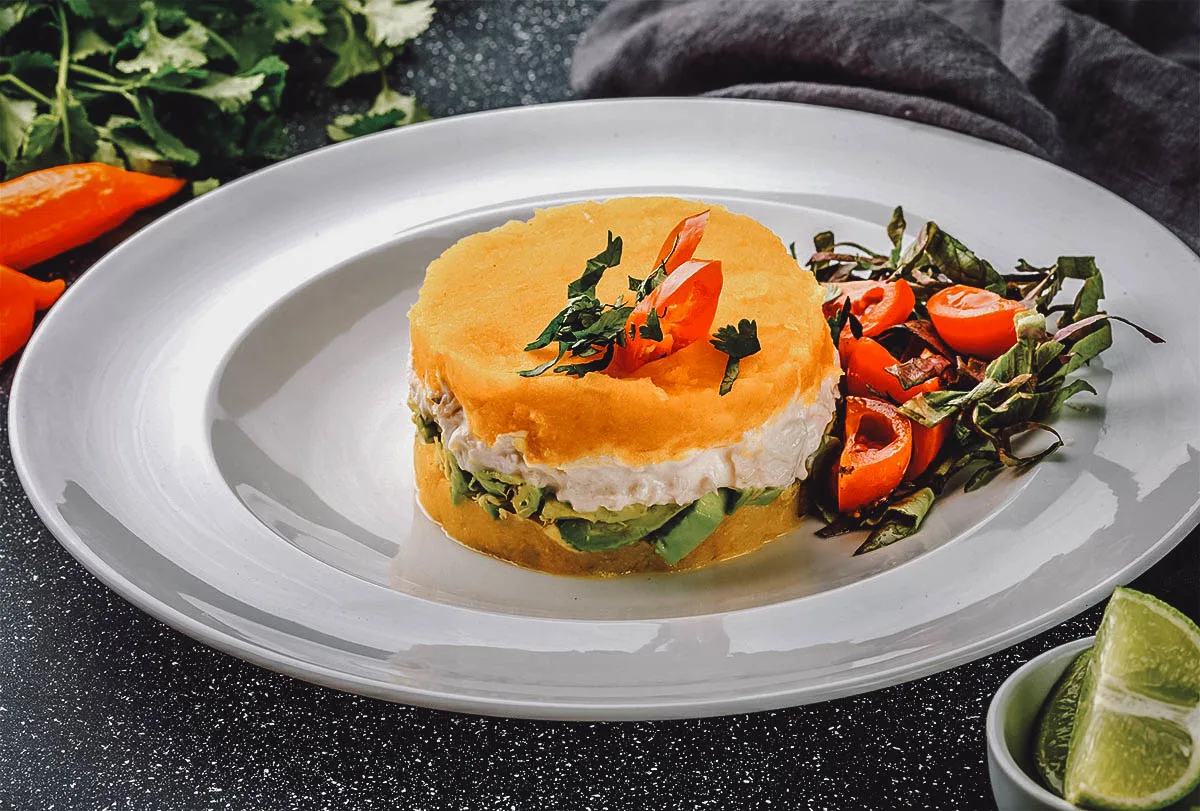
Photo by Blinovita
23. Rocoto Relleno
If you’re a fan of stuffed pepper dishes like dolma or pimiento relleno, then you’ll surely enjoy rocoto relleno as well.
Rocoto relleno refers to a Peruvian stuffed pepper dish originally from Arequipa. It’s derived from a Spanish dish made with stuffed bell pepper. The same sweet peppers weren’t available in Peru so they used the much hotter rocoto pepper instead.
To make rocoto relleno, rocoto peppers are first boiled in water and vinegar to remove as much heat as possible. They’re then filled with various ingredients like seasoned meat, egg, vegetables, tomato sauce, and queso fresco. A milk sauce mixture is poured over the rocoto relleno stuffed peppers before they’re placed in an oven and baked.
RECIPE: Rocoto relleno
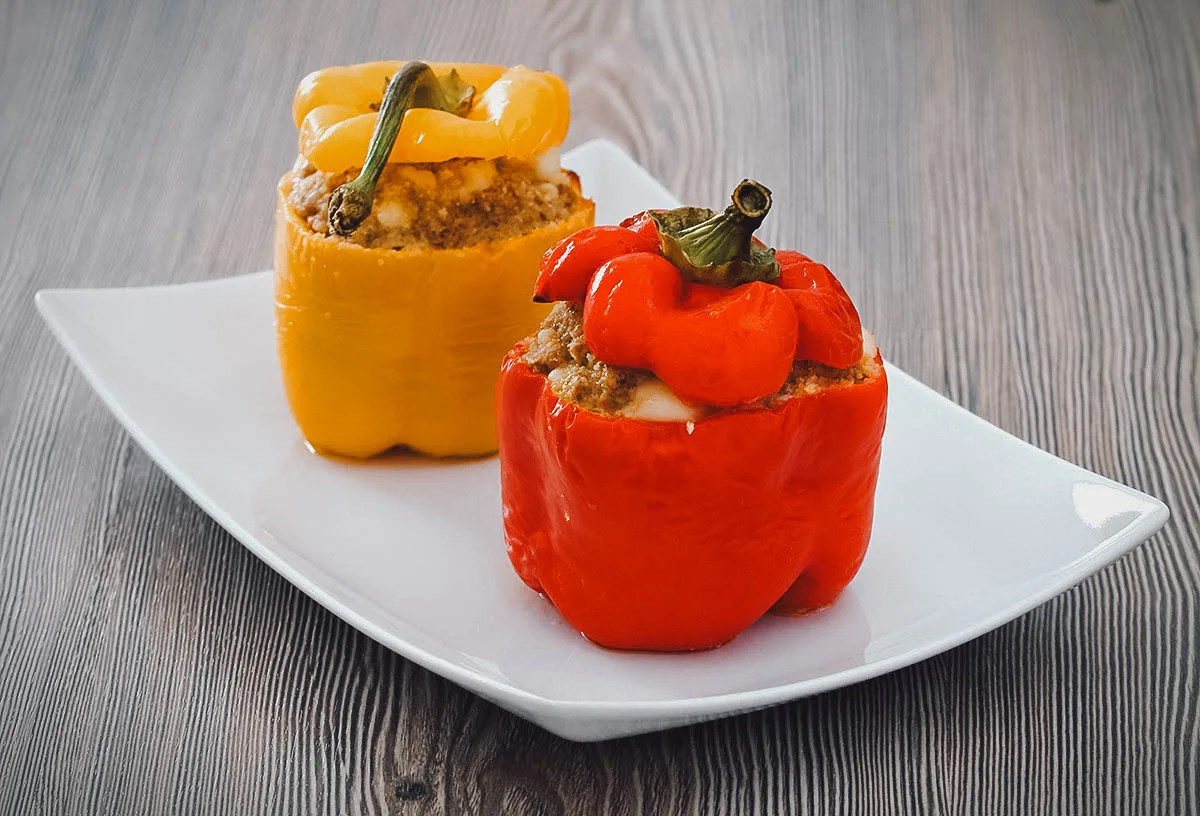
Photo by milla74
24. Papa Rellena
Papa rellena refers to a type of Peruvian croquette made with a filling of ground beef, onions, olives, hard-boiled egg, cumin, and other spices. They’re popular in Peru and in many parts of Latin America like Bolivia, Chile, Colombia, the Dominican Republic, Cuba, and Puerto Rico.
In Peru, papa rellena is typically eaten with salsa criolla or aji sauce. They’re commonly sold as street food though they’re widely available at restaurants and often made at home as well.
Interestingly, papa rellena may have been invented during the War of the Pacific. Peruvian soldiers needed food that was durable and portable, so they’d cook seasoned meat and stuff it into hollowed-out potatoes before frying them. After the war, they took the dish home with them and it’s since become one of the most popular snacks in Peru.
RECIPE: Papa rellena
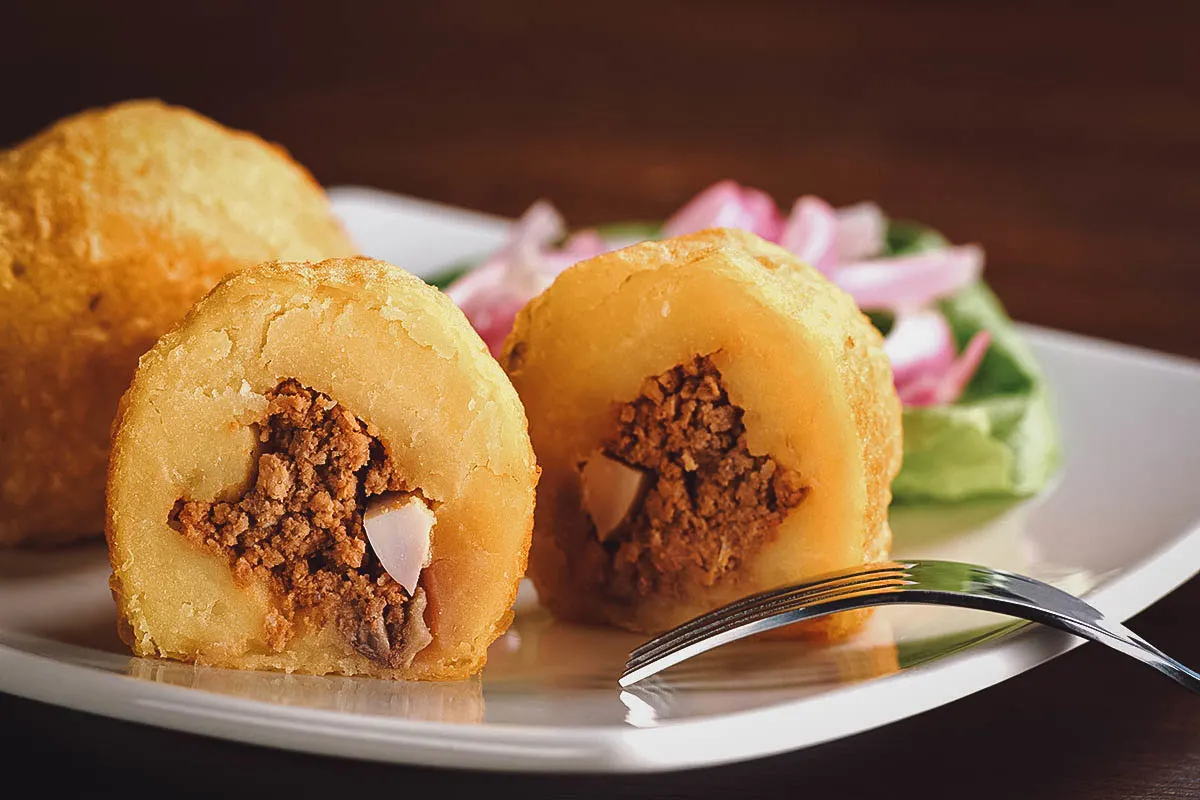
Photo by ildi_papp
25. Tacu Tacu
Tacu tacu refers to a Peruvian rice dish that’s often made with leftover rice and beans. The leftovers are mixed with sauteed onions, garlic, aji amarillo, herbs, and spices before being formed into a pancake-like patty and served with meat, seafood, a fried egg, fried plantains, and salsa criolla.
Tacu tacu is one of the best examples of cocina criolla or Creole cuisine. Though the present-day version of the dish was shaped by the African community, its name is said to be derived from the Quechua word takuy, meaning “to mix two things together”.
RECIPE: Tacu tacu
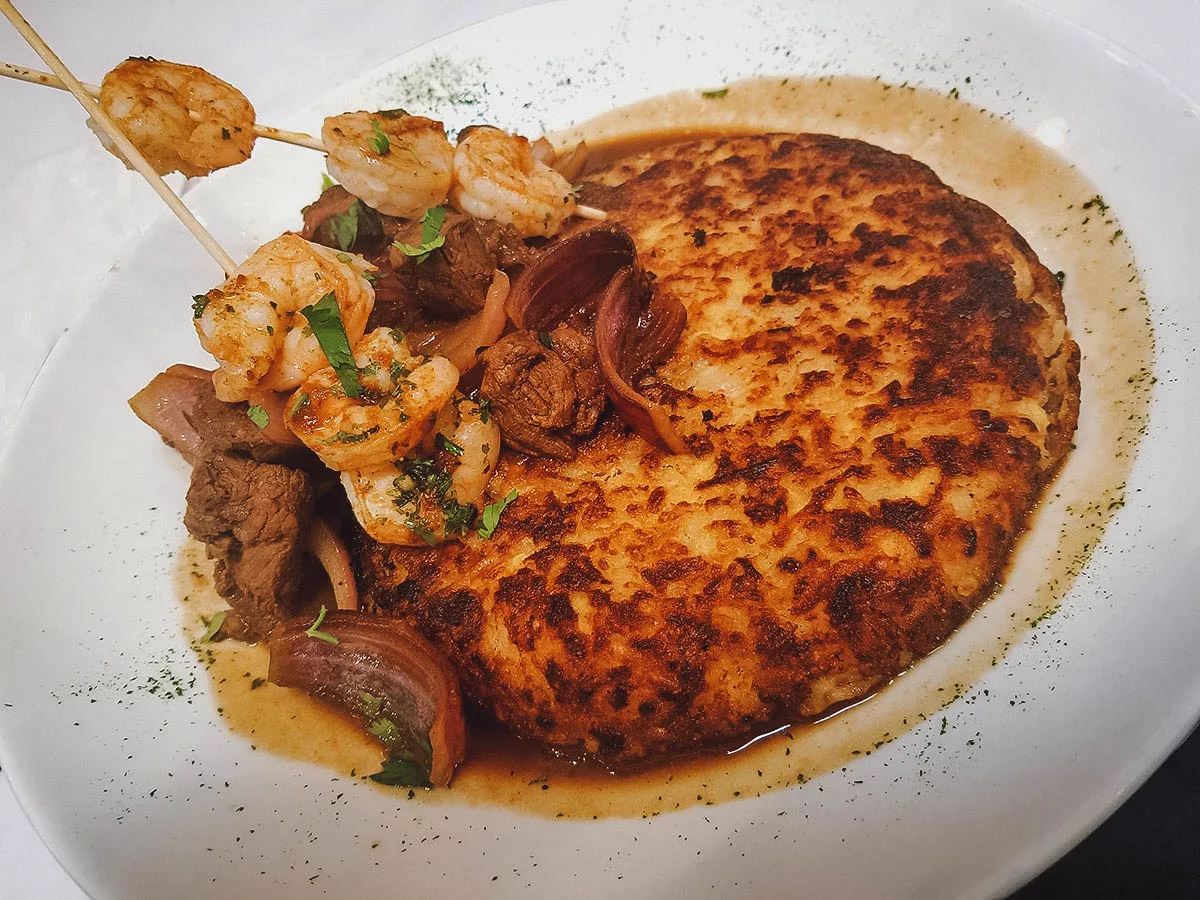
Photo by alexmillos
26. Solterito
Solterito refers to a traditional Peruvian salad originally from Arequipa. It exists in many forms in Peru but common ingredients include rocoto pepper, fava beans, onions, queso fresco, tomatoes, corn, olives, parsley, red or white wine vinegar, and olive oil.
In some parts of Peru, the dish is called soltero, meaning “single man”. Solterito is a diminutive form of soltero, so it literally means “little single man”. The reasons for the dish’s name are unclear but some believe it may have something to do with how easy it is to prepare, making it an ideal dish for single men.
RECIPE: Solterito
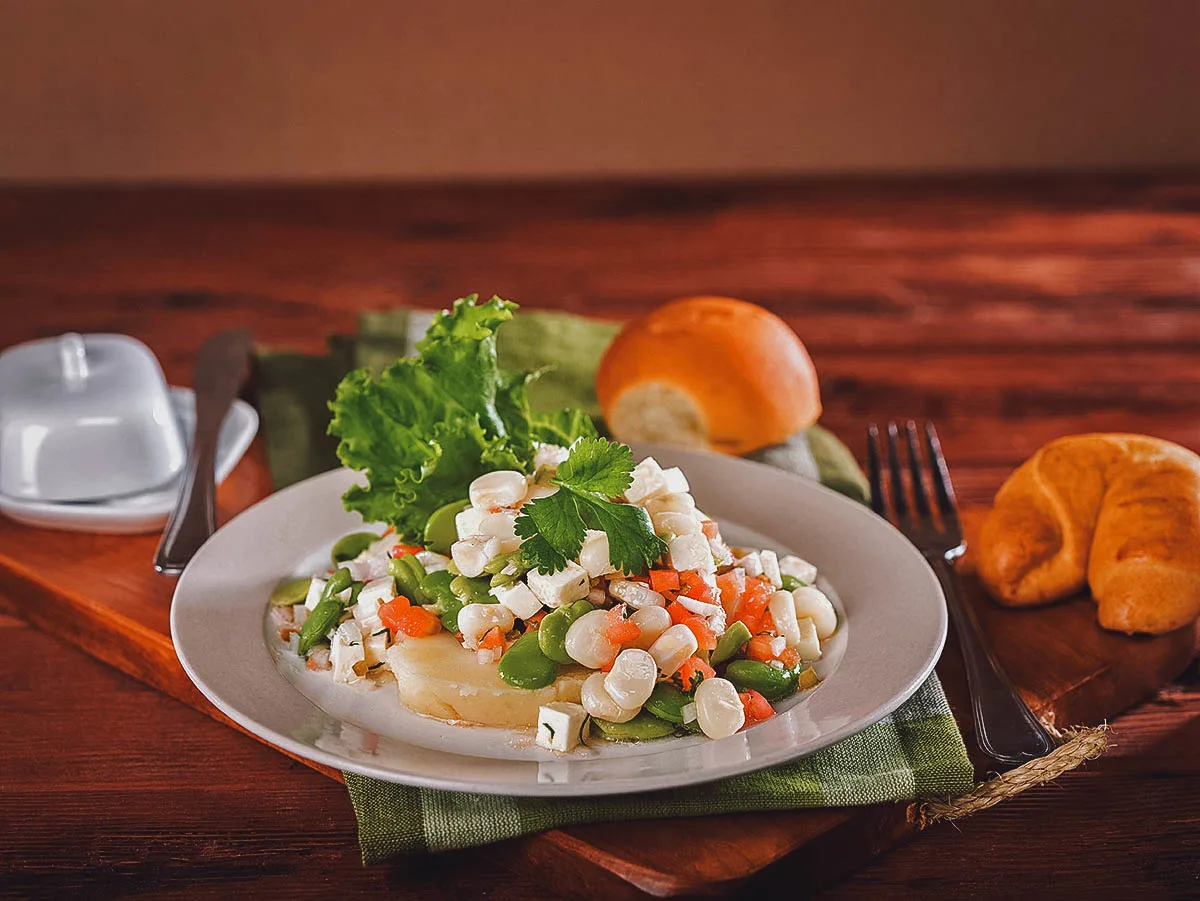
Photo by Hannleonphoto
DESSERTS
Be sure to check out our article on Peruvian desserts for more sweet treats to try in Peru.
27. Picarones
Picarones are Peruvian doughnuts made with squash and sweet potato drenched in chancaca sauce. They’re said to be derived from buñuelos, a type of doughnut brought to Peru by Spanish conquistadores.
The ingredients for buñuelos were too expensive at the time so Peruvians started substituting them with squash and sweet potato. The dish caught on and it’s since become one of the most popular dessert snacks in Peru. They’re often eaten for dessert with anticuchos though personally, I’d love to have them with some queso helado (Peruvian ice cream)!
RECIPE: Picarones
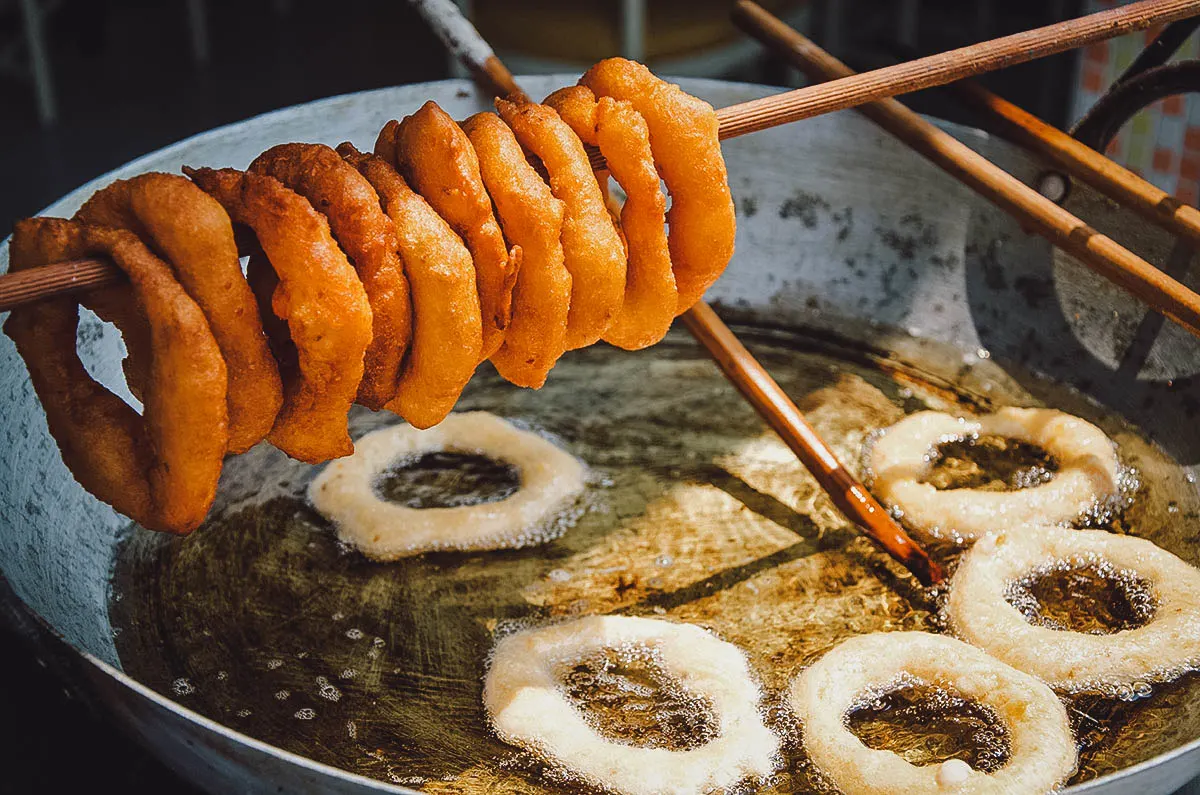
Photo by Peruphotoart
28. Mazamorra Morada
Mazamorra morada refers to a popular Peruvian dessert made with purple corn (maiz morada). Known for its characteristic deep purple/burgundy color, it’s a pudding-like dessert made with various fruits like raisins, prunes, apricots, peaches, pineapple, and sour cherries. Maiz morada is also used to make the popular Peruvian corn drink known as chicha morada.
RECIPE: Mazamorra morada
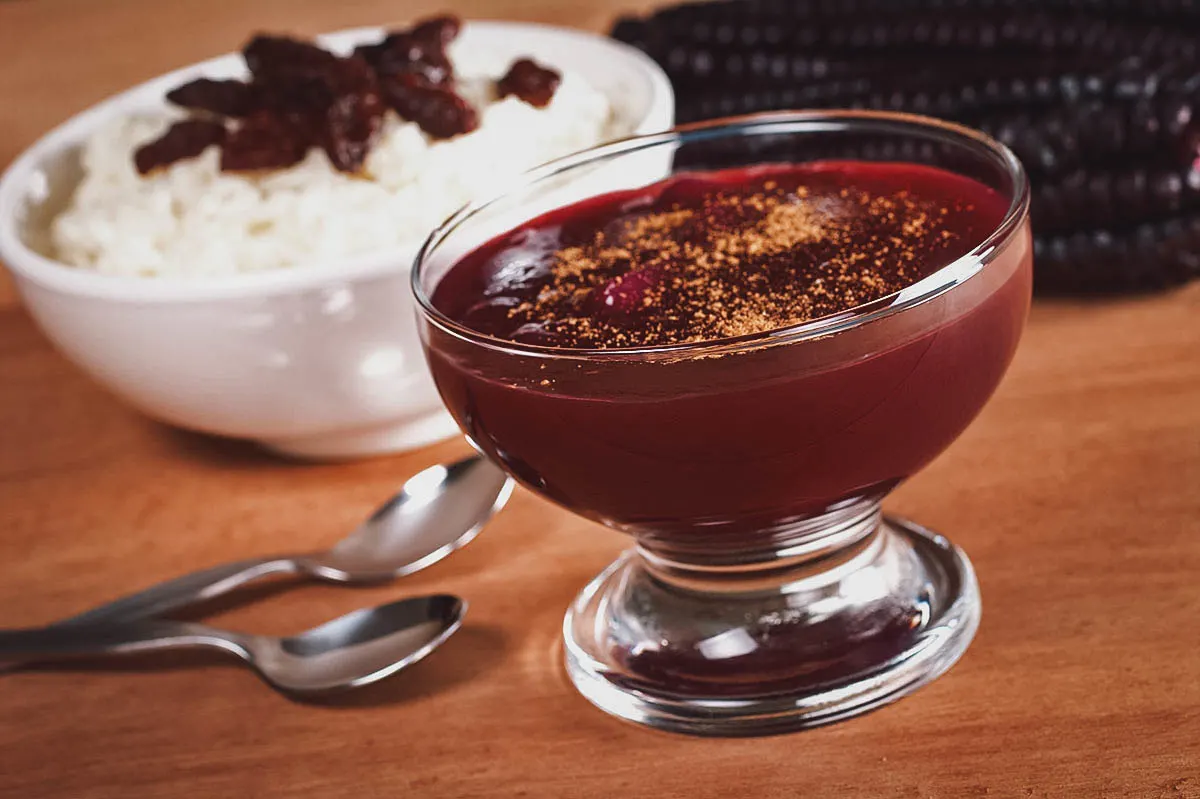
Photo by ildi_papp
29. Alfajores
Alfajores are cookie sandwiches made with buttery cookies and a sweet filling, usually dulce de leche. They were brought to Peru from Spain and have become popular in many countries throughout the Americas, especially in Argentina where it’s regarded as a national symbol.
Depending on where they’re from, alfajores can come in many shapes and forms. In Peru, most cookies are typically about 1-2 inches wide and made with equal parts corn starch and white flour. They contain a good amount of butter and are sandwiched together with manjar blanco (dulce de leche).
Some of the most notable types of alfajor in Peru include alfajores from Cajamarca and Arequipa. Cajamarca alfajores are about 4-5 inches wide and made with fried instead of baked cookies, while alfajores from Arequipa consist of thinner and crunchier cookies filled with milky caramel or honey.
But perhaps the king of Peruvian alfajores is the aptly named King Kong alfajor from northern cities like Chiclayo and Trujillo. These measure about 5 inches wide and high and are made with a variety of fruit-flavored manjar blanco fillings.
RECIPE: Peruvian alfajores
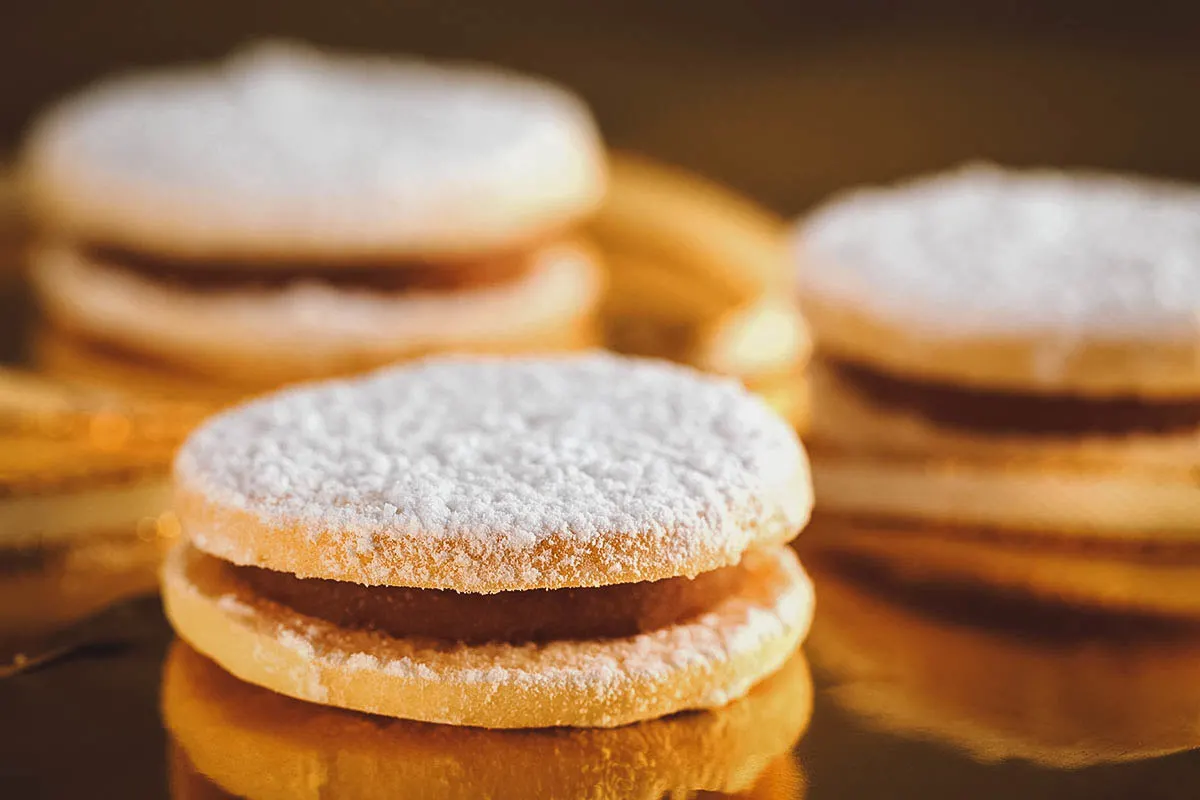
Photo by ildi_papp
30. Cocadas
Cocadas refer to coconut macaroons popular in many parts of Latin America. Their main ingredient is grated coconut but they can be made with other ingredients as well like chopped nuts and dried fruit.
Cocadas exist in many variations and can vary greatly in shape, size, color, flavor, and texture. In Peru, they’re sometimes made into sandwiches and filled with manjar blanco, like alfajores.
RECIPE: Peruvian cocadas
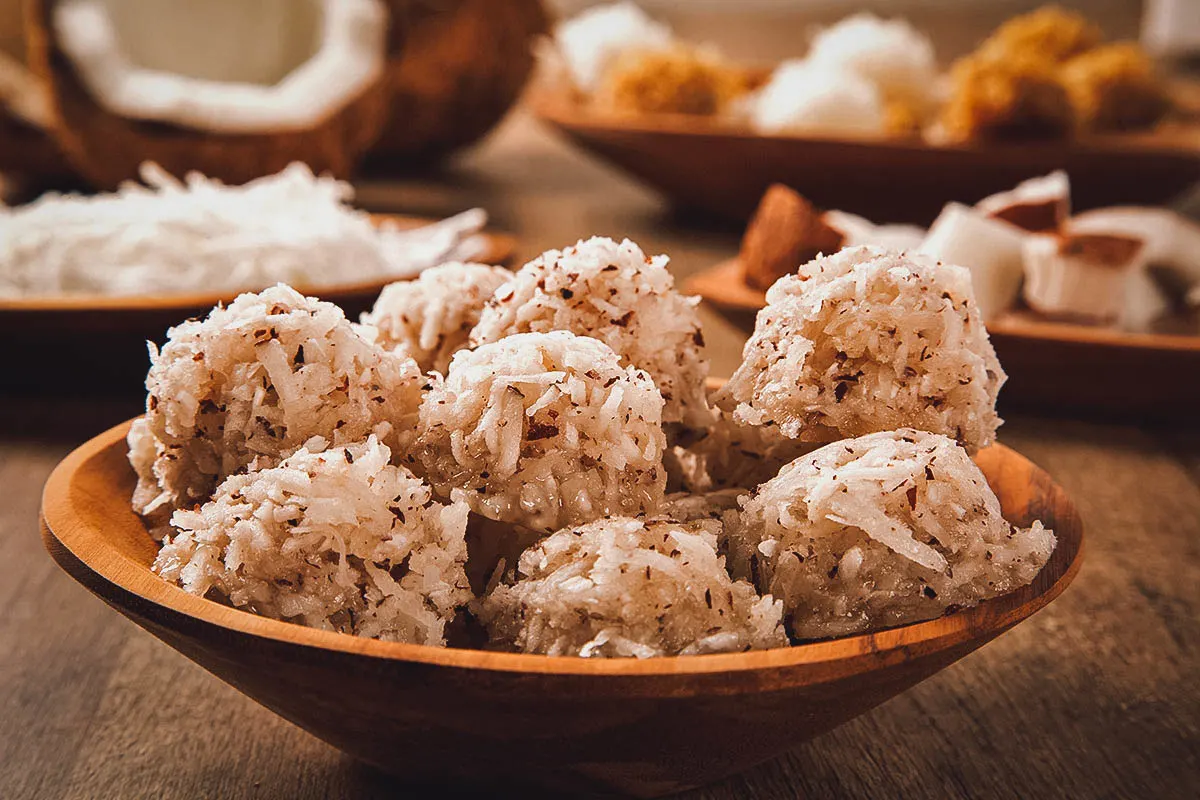
Photo by Paulovilela
PERUVIAN FOOD TOURS
Needless to say, no one knows traditional Peruvian food better than a local, so what better way to experience the food in Peru than by going on a guided tour? A knowledgeable guide can take you to the city’s best restaurants, markets, and street stalls so you get the best and most authentic Peruvian dining experience possible.
If you’re visiting Peru, then check out Get Your Guide for a list of food tours in Lima, Cusco, and other cities in Peru.
PERUVIAN COOKING CLASSES
Aside from food tours, a great way to learn about Peruvian cuisine is to take a cooking class. Food tours will lead you to some of the best places to eat in Peru, but taking a cooking class and actually working with Peruvian ingredients will give you a more intimate look at the cuisine.
If you enjoy cooking and want to learn more about traditional Peruvian food, then check out Cookly for a list of cooking classes in different cities in Peru.
FINAL THOUGHTS ON PERUVIAN FOOD
Thirty dishes represents a minute fraction of Peruvian cuisine but it’s more than enough to demonstrate just how diverse and interesting traditional Peruvian food really is.
From its indigenous dishes to its Nikkei and chifa cooking traditions, people who travel for food have much to be excited about in Peru. No wonder it’s been declared the best culinary destination in South America almost every year!
With two Lima restaurants firmly in the top ten of the world’s 50 best restaurants, that isn’t a trend that looks to reverse anytime soon.
Disclosure
Some of the links in this Peruvian food guide are affiliate links. We’ll get a small commission if you make a purchase at no added cost to you. As always, we only recommend products and services that we use ourselves and firmly believe in. We really appreciate your support as it helps us make more of these free travel guides. Muchas gracias!
Cover photo by shootme. Stock images via Depositphotos.


John
Monday 13th of June 2022
I just wanted to share something that is not widely publicized that I learned while in Lima. Picarrones, similar to anticuchos, are the result of adaptations made by enslaved Africans in Peru.
JB & Renée
Wednesday 15th of June 2022
Thanks for sharing John! The origins of food are always interesting.
Ana
Saturday 27th of November 2021
Peruvian food is simply delicious. Remember if you are not use to eat spicy food, have the waitress put spices on the side... then you can Ventura, slowly but surely :)
JB & Renée
Sunday 28th of November 2021
Thanks for the tip Ana! But no fear of spicy food here. The spicier the better! :)